How to Create a Market Research Proposal (+Template)
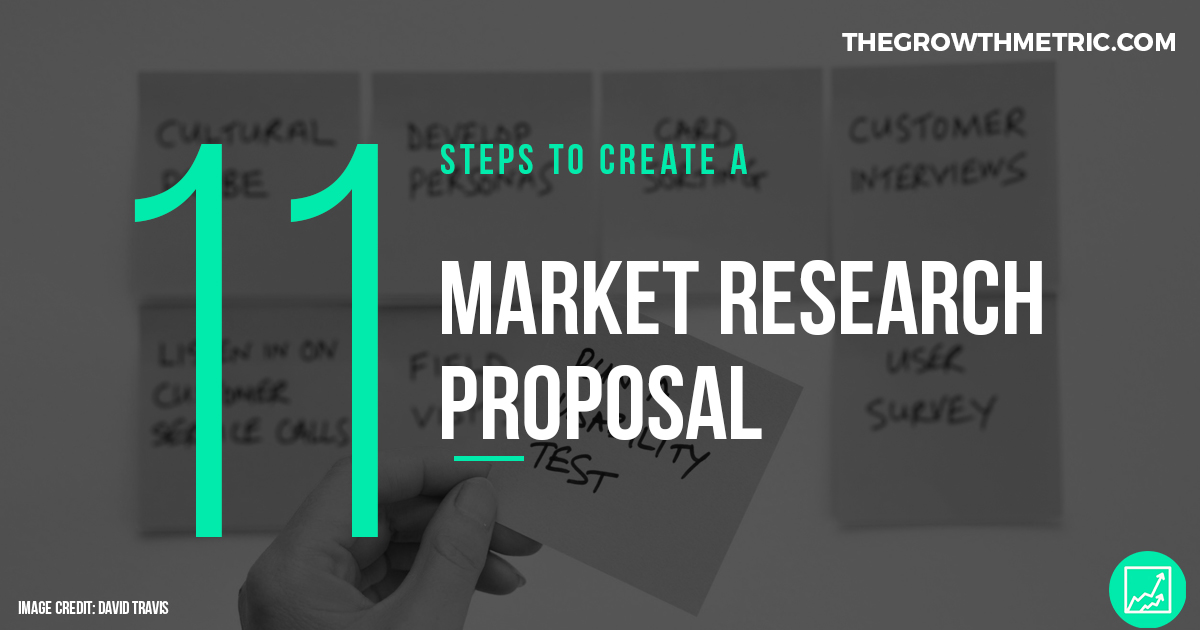
Continuing the market research series, in this article, we’ll discuss what a market research proposal is and how to create one.
To recap, what we’ve covered so far in the series, we’ve talked about what market research is, the different types of market research you need to do to grow your business, and the benefits of conducting market research .

What is A Market Research Proposal
Conducting market research is expensive, and if you work in a large organization, then you would need to justify such expenses.
Before conducting your research you’d need to shed some light on past data about your market, gaps in the data, and why new research is necessary.
This is where a Market Research Proposal come in to play.
Typically, a research proposal is a document proposing a research project, usually, these proposals are done by a scientist or an academic.
The proposals are then evaluated on the cost and potential impact of the proposed research, and on the soundness of the proposed plan for carrying it out. Research proposals generally address several key points:
- What research question(s) will be addressed, and how they will be addressed
- How much time and expense will be required for the research
- What prior research has been done on the topic
- How the results of the research will be evaluated
- How the research will benefit the sponsoring organization and other parties involved
The same principles apply here, only that your business market environment is what is being researched, which is your target market.
A market research proposal is a document that details the what, the where, the when and the how of market research and the information and costs associated with it.
If this sounds complicated, then here’s what you need to know about a market proposal. It addresses:
- Why market research is necessary and what you aim to gain from the research
- What resources are required for the research
- Past research done on your market
- How the data from this market research will be collected, stored and used
- How the research will benefit your business
Keep in mind that at this point you are not conducting the research yet, you are simply providing a rationale behind why market research is necessary.
In the next article in this “Market Research” series, we will discuss the process of conducting market research, but for now, we need to provide a compelling document on why, how, when and where the research will be conducted.
11 Steps to Create A Market Research Proposal

Now that you know what a market research proposal is, it’s time to create one. There are 11 steps to create a sound and compelling market research proposal
1. Market Research Proposal Summary
Start your proposal by briefly explaining the purpose of the market research and why it is required. Also, give an overview of what the desired outcome of the market research is.
If your business is interested in pouring resources into an in-depth market research then surely, there is something you hope to gain from it.
Remember to provide reasoning for the need of this specific market research and let whoever is reading this, such as the CEO, COO. know what contributions this research will make to the company.
TEMPLATE TO USE:
The market research project, entitled [RESEARCH PROJECT TITLE] hopes to discover more information regarding market trends in [SPECIFIC AREA]. The following summary will give an overview of the causes, processes, and possible effects of the market research proposal, detailed below.
2. Research Objectives
In this section of your proposal give full details about what problem has been identified that requires market research to be conducted. I.e. Show why there is a specific need for this research in the first place.
Explain what the market research results will be used for and how they will help achieve the overall goals. Describe the goals which you hope to achieve with this project.
The proposed market research project contains the following objectives:
- Objective one
- Objective two
3. Background Information on Past Market Research
Odds are you’re not the first person/company to conduct research on your market. This means that there is existing information on your market. However, this knowledge might be outdated, or might not provide the data your business needs.
So, in this section explain what information already exists on this topic and what is already known. Also, highlight the gaps in knowledge that the market research will hopefully fill.
Here you will show information from existing sources regarding the specific topic to be researched. It is great to provide cited sources, graphs, charts, and statistics.
You will use this section to show that you know a great deal about the market you will be researching, but you also need to show the holes in the current knowledge.
You can then demonstrate the specific need for your proposed research plan, and how this market research plan will fill these holes and contribute to the knowledge of this subject.
4. Market Research Proposal Hypothesis
If your business needs to conduct market research, then you probably have a few ideas of what you hope to get or learn from the research.
In this section describe what you believed to be the likely outcome of the market research and what you hope to learn.
5. Research Target Audience
Your business doesn’t target everyone, and odds are your business targets different audience types. So who is this research targeted at?
This is a very important part of your proposal and you need to be as detailed as possible about the target audience or audiences you will be researching.
Also, describe how you will source this target audience and how you will ensure they meet the correct criteria.
6. Data Collection of Market Research
Time to get to the good stuff. In this part of your proposal, you MUST detail all the data collection methods that will be used during the market research and, how they will be carried out.
You MUST also explain how the accuracy of data will be maintained, how potential candidates for the research will be approached and, if applicable, how they will be reimbursed for their time and contribution.
Use specifics and consider potential questions such as.
- How will you maintain the accuracy of data?
- How will you approach potential survey or research candidates?
- Will these participants be paid for their time?
- At what times of day will you make phone calls?
- In what ways will you ensure an accurate data sample?
The more information you can provide in this section, the better.
Our methods of data collection will be best suited to the project at hand. Research methods will include:
- Focus groups
- Collection of social media data
- Surveys via the Internet, phone, or email
- Long range in-home consumer tests
- Distribution of samples
- In person promotionals
These individuals will be selected [HOW THEY ARE SELECTED] to ensure an appropriately constituted pool of data from which we can infer accurate insights and trends.
The pool itself comprises of individuals who have expressed to us an interest in participating in such surveys, and they will be compensated by [METHOD OF COMPENSATION]….
7. Research and Analysis Methodology
In this section of your proposal, you are to discuss the strengths and possible limitations of your research methods.
Provide an overall blueprint for your methodology in approaching research data, and describe the implications of each method of data collection, and explain the methods you will use to interpret the data.
Lastly, discuss the means of evaluating the collected data and how you will account for errors, holes in data, or inaccuracies.
8. Ethics to be Followed During Research
You’re almost done with your proposal, but there are still a few important details that need to be included.
Explain how the market research will adhere to ethical codes by thinking about how issues such as participant confidentiality, data security, privacy, and consent of research participants will be addressed.
Include waivers or documents you plan to provide to research participants, if applicable
9. Market Research Timeline
In this section, provide a detailed timeline of when the research needs to begin and when a full report is required, ensure sufficient and realistic time for both data collection and data analysis are considered.
Market Research Timeline
- Task 1 ([DATE] [TIME])
- Task 2 ([DATE] [TIME])
- Task 3 ([DATE] [TIME])
10. Market Research Budget
We’re almost done with our proposal, but it’s time to include arguably the most important section. After all, if your company does not have the funds and resources then there would be no research in the first place.
Provide an overall budget for the proposed project. Make sure to include all possible cost considerations. You can provide a breakdown of those here.
Don’t forget budgets for sections such as Participant Reimbursement, funds for documents, rental space.
11. Conclusion
This is the last part of your market research proposal. You can add ways in which this market research will provide further benefits or include unique applications of the potential results.
Now that you know the market research proposal process and the importance of market research, in the next article will discuss the actual market research process.
Comment with any questions you have about Market Research Proposals and I will get back to you ASAP.

Receive Growth Marketing Resources Directly To Your Email
Join The Growth Metric's mailing list to receive the latest resources and blog posts.
Almost there, click on the confirmation email!
Post navigation, leave a reply cancel reply.
Your email address will not be published. Required fields are marked *
This site uses Akismet to reduce spam. Learn how your comment data is processed .
Focus Groups
How to Write a Market Research Proposal
The market research proposal is an important first step in near all studies. First and foremost, a skeleton that details a study’s direction, goals, and focus, such proposals are typically the first point of reference for management. While the proposals make or break a project’s funding, there is one other strength no research team can ignore: direction.
Critical for any undertaking that involves research, direction helps with both the pragmatics and concepts of near all studies. Market research proposals are vital for outlining both. They also explain the potential returns or results a study can yield. Ideally, the proposal should convince outside readers while informing research and development teams.
Language is important for writing a proposal, as is organization. A lot of detail goes into the typical research proposal, and sometimes there is no clear place for essential odds and ends. Luckily, there is a general organization, or logic, that most research proposals adopt. This allows readers to quickly absorb details, jump to pertinent sections, and digest its conclusions.
While not mandatory, using these structures add a cohesion that makes reading these papers more convenient and cohesive. Length, detail, and overall complexity are all factors when considering how a research proposal should be organized. Similarly, weigh the study’s goals and potential returns. Not every proposal necessitates the same sections. In fact, simple studies can do without a lot of sections that more involved or longer studies require. That mentioned, never write off these critical five elements of your research proposal.
Overview, Definition, and Terms
Important for summing up the study’s incentives, intents, and overall feasibility, overviews prep readers for the project’s strengths. Like everything else in a proposal, clarity is also all-important. Definitions and terms are vital. Overviews are also excellent for showcasing market conditions, opportunity, goals, and overall impact to ROI. While very important, always make sure to focus on the client. Their edification should be at the forefront of any proposal writer’s mind.
Hypothesis and Goals
While referenced in the overview, extrapolation about a project’s actual agenda goes a long way. Near everyone reviewing a research proposal will search for a hypothesis. While fine to reference in the overview, an outright hypothesis will always predominate the research proposal and its direction. Be clear as possible!
The hypothesis itself, however, explains the goal’s prospective burdens, costs, and returns. Also explain how these different elements combine to form a whole level of different parts. Perhaps most intrinsic is the order of said goals, as well how they compliment each other.
Realizing goals requires exploring a range of target segments that can appreciate the product, content, or whatever else. Exploring these different targets includes any range of periphery methods, not to mention actual possibilities. What is vital, however, is a full explanation as to why the target is pertinent.
Methodology and Conditions
The logical extension, research proposals must detail methodology. Include practices and conditions, study types, analysis standards, and other crucial aspects. Make sure extrapolation focuses on the actual methodology, however. Pragmatic intricacies can be glossed over, but that really depends on the reader. Researchers will typically want to know about the whole process, while management typically focuses on efficacy and ROI.
Discuss.io can offer deliverables within 48 hours, the fastest in the industry. Establishing a clear timeline is still critical though. Product and content dev teams typically need to keep informed. A common timeline really encourages such cohesion, not mention also keeps MR better aware as to the product or content’s direction. Along with setting a schedule, timelines also helps inform team members of their objectives and schedule. Such a cohesive view both informs researchers as reminds them of the importance of each task.
Source: https://creativecommons.org/licenses/by/2.0/legalcode
Start a conversation with us to learn more about how you can better understand and build empathy with consumers through real-time conversations.
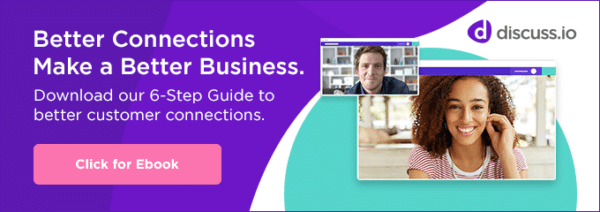
Sign Up for our Newsletter
Related articles.

How to Facilitate Meaningful Insights: Strategies for Effective Focus Group Discussions
Conducting a worthwhile focus group requires a strong purpose and well-defined objectives. This isn’t an ordinary…

How to Optimize Engagement with a Virtual Focus Group: Strategies and Tips
Creating successful engagement in virtual focus groups starts with proper planning. This involves everything from the…

Maximize the number of research projects completed by year’s end: Yes, it can be done
Ask most agencies managing enterprise-level market research (MRX) projects, and they’ll tell you they have a…

- Tour Solutions Resources Pricing
- Contact Sales
- START FREE TRIAL
- All Industries >

How To Write Market Research Proposal: Tips and Best Practices

Entrepreneurs and companies need to get critical information about their industry or specific market landscape to help ensure their business becomes a success.
This is where market research plays a role. But to be effective, proper steps must be outlined through a market research proposal.
If you’re a business owner or a marketer, you must learn how to write a market research proposal correctly . So here’s a handy step-by-step guide on how to do just that. Plus, we’ll throw in a free template to help you get started.
Table of Contents
How To Write a Market Research Proposal
When drafting a market research proposal , you can adopt various styles depending on the industry or business. But to put forth a more organized proposal, it helps to adhere to proven structures and follow these steps.
1. Start with an overview
It’s always wise to open with an overview to give the readers of the proposal a general idea of what the market research is all about, as well as set their expectations. If you don’t want to use the term overview, you can also go with an executive summary or an introduction.
You can do a simple overview consisting of one to three paragraphs. Or if the situation calls for it, you can also present your executive summary with supporting information that may include any or all of the following:
- Definition of terms. List the terms that will be used in the market research proposal. Make sure to define them properly.
- Market conditions. Give an overall picture of the current market conditions. Explain the industry’s state and the competition level, as well as mention relevant economic or even political factors.
- Strengths, weaknesses, opportunities, and threats (SWOT) analysis. You can also present market conditions through a SWOT diagram, which summarizes everything neatly.
- Feasibility. If you want to cut to the chase, state the overall feasibility. You can also consider including the potential ROI (return on investment ).
2. Define the objectives
When writing a market research proposal, define the project’s goals as clearly as possible. You can begin with a larger, encompassing objective and then break it up with its corresponding parts.
If you are dealing with multiple goals, make sure to explain how each separate objective relates to or affects one another.
Remember that clearly defined goals will guide the execution of the market research project – from the budget to the types of surveys or questions you will use.
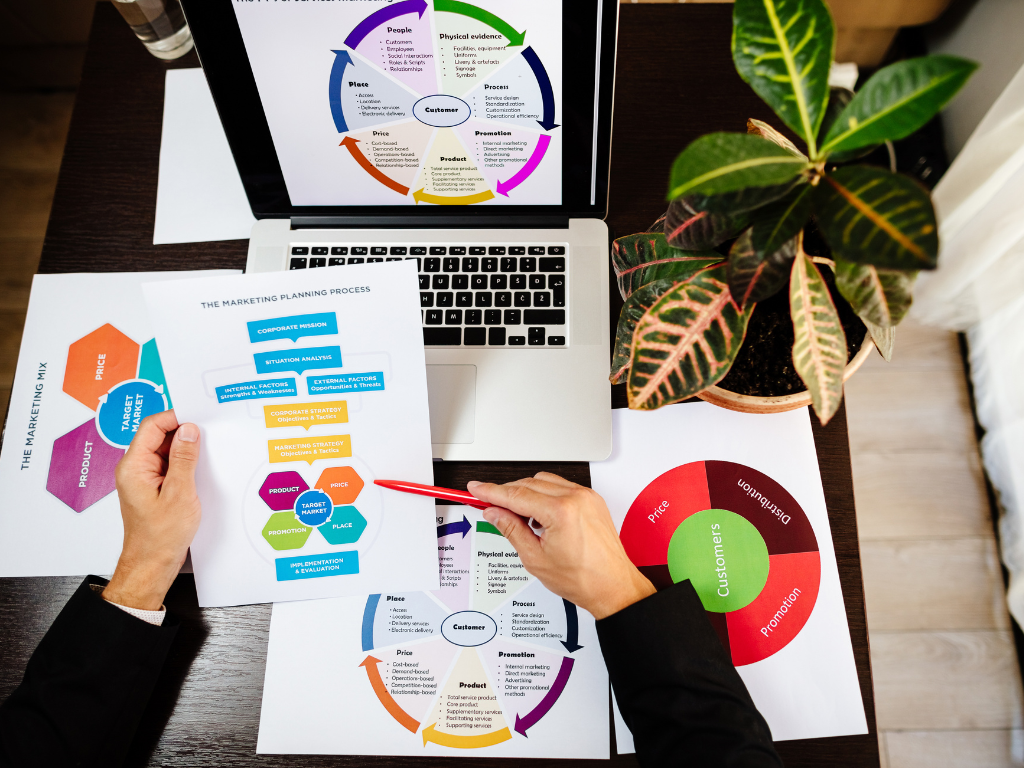
3. Outline the execution
Market research can be accomplished in various ways, but there needs to be a clear plan for executing it.
Outline your methodology and approach to getting the information you need. As far as methods are concerned, you can choose from options like organizing focus groups, deploying online surveys, or holding interviews over the phone or face-to-face.
You should also consider if your approach is multi-faceted. Will the surveys be done once or through a series of batches? Will you follow up on the first wave of interviews with email surveys?
Never forget to include the rationale for choosing your methodology. Factors to remember include costs, logistics, and timeline.
4. Explain how the results will be analyzed and reported
Market research proposal creation would be incomplete without including the mechanics for analyzing and reporting the results.
You must present a concrete plan for how the market research data will be collected and safely stored.
Next on your list is to explain how the data will be analyzed. Of course, what comes after is the reporting part. It’s more than just presenting the facts. You should also include your interpretations and, more importantly, your recommendations.
5. Discuss the timeline, costs, and conditions
Market research takes time and isn’t free. So, you’ll need to define your timeline and expected costs clearly.
It’s also important to tackle the terms and conditions of the market research project. The more transparent you are, the more you can prevent misunderstandings in the future.
Download the Market Research Proposal Template
When drafting a market research proposal, you can accomplish things faster using a reliable template.
Sign up now for a free account at Fill to get a market research proposal template. It’s just one of several templates that we offer for free.

Market Research Proposal
Common Mistakes to Avoid When Writing a Market Research Proposal
It’s not enough to know how to draft a market research proposal. You also have to be aware of common mistakes people commit when preparing these proposals.
- Lack of details. When you already know how to create market research proposals, you use certain structures and templates repeatedly. But sometimes, you forget to add elements that make your proposal look legit instead of being an apparent copy of another.
- There is not enough review and fact-checking. We’re not talking about simple spelling and grammar errors. We’re referring to the information you included in your market research proposal. Are they up-to-date? Are the sources considered trustworthy?
- There is too much hype. Be careful not to get caught up in the excitement of your proposal. Remember that you are dealing with business people. Be realistic and be clear about the goals. The last thing you need is to promise something you can’t deliver.
- Disorganized presentation. You can follow a decent structure when writing your market research proposal. But if you don’t organize the information you present in each section, you will you’re lose your reader’s interest.
- Underestimating visuals and diagrams. Yes, it’s showing real data is important, but you can be more persuasive by strategically using visuals, graphs, charts, and tables in your proposal.
Using Fill to Create Your Market Research Proposal
Now that you know how to write a market research proposal, it’s time to put your learnings into practice immediately.
Create an account at Fill and grab a free market research proposal template today.
Andria is a seasoned content writer, specializing in document management solutions and HIPAA compliance, providing valuable insights for businesses and professionals alike.
Manage contracts, forms and eSignatures effortlessly.
Related Stories

How to Draft a Training Proposal: A Complete Guide
Do you provide corporate training services? Or if not, are you planning to? You can attract new clients if you know how to draft training proposals properly. If you need help in that department, we have your back. We’re giving you this step-by-step guide on writing a proposal. Plus, we’re also going to give you a free template to get you started.

A Comprehensive Guide to Lawyer Signatures
The power of a signature goes beyond mere formality in the legal profession. It's a symbol of authority, authenticity, and personal identity. This article offers a concise guide to perfecting this critical aspect of legal practice. We'll begin by examining the significance of an attorney signature and identifying key components of an impactful one. Additionally, we'll offer strategies for developing a professional attorney at law signature. Keep reading to learn more.

The 8 Best Electronic Signature Apps for 2024
Get great articles direct to your inbox
We’ll never share your details with third parties. View our Privacy Policy for more info.
This feature is currently only available from a desktop computer.

- Our CLT & Focus Group Facilities
- Concept Ideation & Invention Methods
- Creative Problem Solving Research
- Product & Packaging Evaluation
- Consumer / Shopper Segmentation
- Path to Purchase / Journey Mapping
- Virtual Store Testing
- Brand Positioning Research
- Message Evaluation Optimization
- Ad Copy Testing
- Reputation Management
- Brand Equity Assessment
- Market Structure & Landscape
- Competitive Intelligence
- Benchmarking Market Research
- Customer & Employee Satisfaction Surveys
- Habits & Practices / Attitudes & Usage
- Data Presentation & Reporting
- Data Analysis & Interpretation
- Data Processing & Analytics
- Syndicated Data
- Segmentation Algorithms & Panels
- Proprietary Research Reports
- Data Mining
- Consumer Insights
- Sensory Data Analysis
- Crisis Communications
- Marketing & Business Strategy
- Focus Groups
- Face To Face Interviews
- In-Depth Interviews
- Public Opinion
- Web Interviews
- Postal Mail Surveys/Questionnaires
- Interactive Voice Responses
- Public Opinion & Community Engagement
- Leadership Team
- Company Acquisitions
- Testimonials
- Pharmaceutical
- Retail & Consumer
- Agriculture
- Manufacturing
- Marketing & Advertising
- Entertainment
- Finance & Legal
- Food & Beverage
- Travel & Hospitality
- Apparel & Footwear
- Home & Hardware
- Health & Beauty Aids
- Hi-Tech & Ecommerce
- Alternative Energy
- Case Studies
- Project Summaries
- Research Tools
- Join Our Panel
How to Write a Winning Market Research Proposal
The current pandemic may have curbed our travel, but that doesn’t mean we don’t all still know the value of having good maps and a suggested itinerary. Indeed, a solid plan of action makes any endeavor — whether it be a fun-filled vacation, an educational goal, or a professional enterprise — more focused, less stressful, and, thus, more effective. It doesn’t matter if life interrupts our plans (“Hello, COVID-19!”); in fact, interruptions are a given, but we still know that good plans prepare us for whatever lies ahead. They help us to define our priorities and clarify our needs so that we can better manage our resources. The result: we are better prepared to handle uncertainties and more formidable and more productive in whatever we choose to do.
For businesses, good plans are based on good research. More than good products and services, good information sets profitable companies apart from their competition, allowing them to prepare for — and plan for — success. This is why market research proposals are so important. A market research proposal is a document a company uses to map out its future. It unites company stakeholders in joint discovery of information so that everyone knows who and what really matters. In short, a market research proposal outlines the specifics of an information-gathering project. This is how to write a winning one:
Keep It Brief
A market research proposal is sometimes called a “market research brief” because it's just that: brief. It should also be clearly written with no unusual acronyms or industry jargon and only the necessary points to underscore the overall research objective (as well as how it will be addressed) highlighted.
Include a Company Overview
The beginning of the proposal should include a short overview of the company, including such details as its mission and vision statements; market performance history; industry facts, figures, and trends; competitor data points and any other past research findings that shed light on the issue(s) at hand and why further research is needed.
Clearly Define the Objective
The research objective is the most important part of the proposal, as it clearly outlines the information a company needs, and, thus, defines the overall goal of the project. It’s basically the question a company wants to be answered and needs to be specific and measurable (but not necessarily quantitative) with the desired outcome.
Explain the Research Methodology
Of course, a market research proposal should also include a section explaining how the information to address the research objective will be obtained. Details about data collection (including the definition of the target audience, sample selection criteria, and proposed methodology) need to be clarified (since specific demographic, technological, economic, political, and even environmental concerns inevitably impact research outcomes) and should be evident with reasons for their use thoroughly transparent.
List Expected Outcomes
Finally, a good market research proposal needs to include a list of expected outcomes. An estimation of budget concerns, as well as a timeline for specific research milestones and project completion, should be listed here, along with an overview of projected deliverables to be anticipated. This helps both company executives and researchers to remain focused and on point.
Ready to Learn More?
A winning market research proposal isn’t just the one that seals the deal on a research project. It’s the one that provides actionable insights for companies and researchers alike. Following a determined set of standards, a winning market research proposal has the potential to garner data that can be used to inform better business decisions. Our team at Research America has the expertise needed to craft winning market research proposals that yield meaningful results for all involved. Please contact us to learn more.
CUSTOMER EXPERIENCE
CONSUMER INSIGHTS
- Marketing Research |
- Market Research Surveys |
- Market Research Company |
- Market Research Interviews |
- Market Research Calls |
- Market Research News |
- Market Research Initiative |
- Privacy Policy |

- Join the AMA
- Find learning by topic
- Free learning resources for members
- Certification
- Training for teams
- Why learn with the AMA?
- Marketing News
- Academic Journals
- Guides & eBooks
- Marketing Job Board
- Academic Job Board
- AMA Foundation
- Diversity, Equity and Inclusion
- Collegiate Resources
- Awards and Scholarships
- Sponsorship Opportunities
- Strategic Partnerships
We noticed that you are using Internet Explorer 11 or older that is not support any longer. Please consider using an alternative such as Microsoft Edge, Chrome, or Firefox.
Market Research Proposal Template
Use this template to create a proposal for a market research study.
- Estimated time required: 4 hours
- Skills required: Proposal writing
Get Full Access to This Resource With AMA Membership

Market Research Playbook
This tool can be used alone, but it’s also part of the comprehensive Market Research Playbook. It provides step-by-step planning guidance while also helping you utilize more than 25 downloadable tools from the popular AMA Marketer’s Toolkit library.
This tool is powered by Demand Metric .
By continuing to use this site, you accept the use of cookies, pixels and other technology that allows us to understand our users better and offer you tailored content. You can learn more about our privacy policy here
Proposal Template AI
Free proposal templates in word, powerpoint, pdf and more
Market Research Proposal Template: A Comprehensive Guide + Free Template Download + How to Write it
The importance of a market research proposal template.
As a market researcher, I understand the importance of creating a comprehensive and well-organized market research proposal. This document serves as a roadmap for our research process , outlining the objectives, methodology, and timeline for our project. However, creating a proposal from scratch can be time-consuming and challenging. That’s where a market research proposal template comes in. This template provides a structured framework for developing a thorough and professional proposal , saving time and ensuring that all necessary components are included. In this article, we will explore the key elements of a market research proposal template and discuss why it is an essential tool for any successful market research project.
Market Research Proposal Template
Executive summary.
The purpose of this section is to provide a brief overview of the market research proposal. It should include the objectives of the research, the methodology that will be used, and the expected outcomes .
Example: In this market research proposal, we aim to investigate the buying behavior of millennials in the automobile industry. We will utilize a combination of surveys, focus groups, and data analysis to understand the preferences and decision-making process of this demographic. The expected outcome is to provide actionable insights for automobile companies to effectively target and appeal to millennials.
My advice on: The executive summary is a crucial part of the market research proposal as it sets the tone for the rest of the document. It should be concise yet informative, capturing the essence of the research project .
This section outlines the specific goals and objectives of the market research. It should clearly define what the research aims to achieve and how it will contribute to the organization’s strategies.
Example: The objectives of this market research include: 1. To identify the key factors influencing millennials’ purchasing decisions in the automobile industry. 2. To understand the perception of various automobile brands among millennials. 3. To determine the most effective marketing channels to reach millennials.
My advice on: When outlining the objectives, it is important to be specific and measurable. This will provide a clear direction for the research and allow for meaningful conclusions to be drawn.
Methodology
This section details the approach and methods that will be used to conduct the market research. It should include a description of the research design , data collection techniques, and data analysis methods .
Example: The methodology will involve a combination of quantitative and qualitative research. Surveys will be conducted to gather numerical data on purchasing preferences and behaviors, while focus groups will provide in-depth insights into millennials’ attitudes towards different automobile brands. Data analysis will include statistical techniques to identify trends and patterns.
My advice on: When describing the methodology, it is important to justify the choice of methods and demonstrate their suitability for the research objectives . This will help to establish the credibility of the research approach .
This section provides a detailed timeline for the market research project. It should outline the key milestones and deliverables, as well as the estimated timeframes for each stage of the research.
Example: – Research planning and design: 1 month – Survey administration: 2 weeks – Focus group discussions: 3 weeks – Data analysis and report writing : 1 month
My advice on: The timeline should be realistic and achievable, taking into account any potential obstacles or delays. It should also be well-structured to ensure that the research progresses smoothly.
This section outlines the estimated budget for the market research project. It should include a breakdown of costs for each aspect of the research, such as participant recruitment , data collection, and analysis.
Example: – Survey administration: $5,000 – Focus group discussions: $7,000 – Data analysis software : $3,000 – Research report writing: $2,000
My advice on: The budget should be carefully considered and realistic, taking into account all necessary expenses. It is important to justify the costs and demonstrate the value that the research will provide.
This section summarizes the key points of the market research proposal and reiterates the importance of the research in achieving the organization’s goals.
Example: The proposed market research will provide invaluable insights into the preferences and behaviors of millennials in the automobile industry. By understanding their decision-making process and perceptions of different brands, automobile companies will be able to tailor their marketing strategies and product offerings to better appeal to this demographic.
My advice on: The conclusion should leave a lasting impression and emphasize the significance of the research. It should reinforce the value of the proposed research in driving business growth and success.
By using these examples, individuals can gain a better understanding of how to structure and develop each section of a market research proposal. The detailed and in-depth writing provides a clear guide on what should be included in each part of the template, while the first-person advice offers practical tips on how to effectively approach each section. Ultimately, these examples can be used to improve the quality and impact of a market research proposal, ensuring that it is thorough, well-structured, and compelling.
Download free Market Research Proposal Template in Word DocX, Powerpoint PPTX, and PDF. We included Market Research Proposal Template examples as well.
Download Free Market Research Proposal Template PDF and Examples Download Free Market Research Proposal Template Word Document
Download Free Market Research Proposal Template Powerpoint
What is a Market Research Proposal?
A market research proposal is a document that outlines a plan for conducting market research, including the objectives, methodology, and timeline for the research.
What should be included in a Market Research Proposal?
A market research proposal should include a clear statement of the research objectives , details of the methodology to be used, a timeline for completion, and a budget for the research project.
Why is a Market Research Proposal important?
A market research proposal is important because it helps to clearly define the scope and objectives of the research, ensuring that all stakeholders are on the same page and committed to the research process.
What are the key components of a Market Research Proposal?
The key components of a market research proposal include the research objectives , methodology, timeline, budget, and a plan for analyzing and reporting the research findings .
How should a Market Research Proposal be presented?
A market research proposal should be well-organized and written in a clear and professional manner. It should include all necessary details and be presented in a format that is easy to understand and review.
What are some common challenges in creating a Market Research Proposal?
Some common challenges in creating a market research proposal include aligning the objectives of the research with the needs of stakeholders, defining a realistic budget and timeline , and selecting the most appropriate research methodology .
Who should be involved in the development of a Market Research Proposal?
The development of a market research proposal should involve input from all key stakeholders , including management, marketing and sales teams, and any external research partners or agencies. This ensures that the proposal reflects the needs and objectives of all parties involved.
What is the key purpose of a Market Research Proposal?
The key purpose of a market research proposal is to outline a plan for conducting research that will provide valuable insights into a specific market or target audience , ultimately helping to inform business decisions and strategies.
Related Posts:
- Research Proposal Template: A Comprehensive Guide +…
- Music Business Proposal Template: A Comprehensive…
- Project Proposal Template: A Comprehensive Guide +…
- Simple Proposal Template: A Comprehensive Guide +…
- Fundraising Proposal Template: A Comprehensive Guide…
- Academic Proposal Template: A Comprehensive Guide +…
- Business Research Proposal Template: A Comprehensive…
- Proposal Template: A Comprehensive Guide + Free…
Market Research Proposal Template To Close Deals
Companies that conduct market research and analysis can use our sample marketing research proposal template as an example of how to write a market research proposal, and as a guide when preparing survey proposals, data collection proposals, or business research.
This template allows you to explain your methodology for gaining qualitative and quantitative research, and provides a section to break down your research timeline into phases. It also includes a statement of work section to clarify what the customer will receive from the research, along with a detailed contract

All Proposify proposal templates are 100% customizable.

Executive Coaching Proposal Template
Companies preparing proposals coaching services can use this executive coaching proposal template when pitching their services to potential clients.

AdWords & PPC Proposal Template
The perfect pitch guide for marketing agencies offering pay-per-click (PPC) advertising services like search engine marketing (SEM) and Google Adwords.
Learn why over 10,000 businesses love Proposify
Drag & drop library sections
Managing proposals is a breeze in Proposify. Save all your case studies, fees, images and team bios all in one central library.
Tag them, search them and drop them into your layout. Proposals just got... dare we say... fun?
Online previews & signatures
No more emailing big PDFs, printing and shipping proposals or faxing back signatures (ugh). Your client gets a branded, interactive proposal they can sign off electronically. No need for extra software or logins. Oh, and we tell you as soon as your client opens it.
Track everything
Keep a pulse on your the sales pipeline of your agency. Proposify lets you know your close rate, which sections of your proposals get viewed and for how long, and all kinds of insight into what goes into your most successful proposals so you can sell smarter.
Sync up your other apps
Proposals are just one part of your agency sales process. We tie together your other software, so you can import contacts from your CRM, auto create deals and generate invoices in your accounting software. We are regularly adding new integrations.
Customer Support to the Rescue
We understand that when you’ve got questions, especially when you’re on a tight proposal deadline, you NEED answers. Our customer happiness specialists are at the ready, armed with friendly, helpful, timely support by email or online messaging. We’re here to help, regardless of which you plan you’re on or if you’re just taking us for a test drive.
We Keep Your Data Safe and Private
When it comes to protecting your private information, we’ve got it locked down tighter than Alcatraz. We partner with Amazon Web Services, use 128-bit SSL encryption, and create daily backups. And we never, EVER disclose any data to third-parties without your permission. Rest easy, nothing’s getting out of here alive.

Ready to see Proposify in action?
Sign up for a custom demo to give Proposify a test drive and get all your questions answered.
Free Marketing Research Proposal Template
Fully editable with custom branding and templated offering.

Bonsai has helped create 1,023,928 documents and counting.
Table of contents

What is a Marketing research proposal?
A marketing research proposal is a document designed to sell your services by showing potential clients the research that you will carry out for their project. Whether you’re a freelance marketing consultant or you have your own marketing agency, a market research proposal will cover what research needs to be done, how you’ll go about it, and why they should choose you for the project.
A proposal is typically one of the first points of contact that you have with an organization. Therefore, it’s a chance to make a strong first impression.
Note: Sign up now to get your free marketing research proposal template that will make yours stand out for all the right reasons.
What to include in the Marketing research proposal
A market research proposal will outline your market research plan and each critical step you need to take to perform the necessary research. It usually consists of three parts.
- Introduction: This includes project objectives and scope, target market, and methodology, including data collection methods.
- Discussion: This covers existing knowledge of the market, case studies or competitor analysis, a project timeline, proposed budget, deliverables, and ethical considerations.
- Summary: This concludes what you expect to achieve from the market research, how it will support the initial objectives, and why your company is the best for the job.
Introduction
At the top of any market research proposal template should be the title of your document followed by who it has been written by and who it’s for. You can also include both company addresses here if you wish.
Proceed to outline the project description and the purpose of performing the market research. What are you trying to achieve? Why is this research needed? Who will be conducting it? What problem are you trying to solve for the client?
You should also include a methodology section in your introduction. The research methodology should dive into what primary and secondary research will be conducted, how data will be collected, and the expected outcomes. As a freelance researcher, you’ll already know this, but it’s worth covering what’s included in each to the client:
- Primary research is research that you carry out yourself in the form of two research methods: qualitative and quantitative research. Qualitative research relies on first-hand observation from things like interviews, questionnaires, and focus groups. Quantitative research, on the other hand, relies on the collection and analysis of data from an online survey and polls.
- Secondary research is research that has already been published and comes from secondary sources. This may include academic literature, print publications, and online studies.
It’s important to give an overview of your target audience in your methodology too.
For instance, if your client is trying to determine whether it’s a good time to launch a new product, your methodology in your market research proposal would explain how you plan to arrange a focus group with their target audience of females aged 16-24. Being present in the meeting, asking the right questions, and making notes to refer to later on would confirm whether the prospective product could be useful and — ultimately — successful.
The discussion section of your marketing research proposal is typically the meatiest. It’s where you should demonstrate what you already know about the industry and company, while getting into the finer details of the market research project.
- Existing Industry Knowledge: Prospective clients are likely going to want to hire someone who knows what they’re talking about. Right? Demonstrate that’s you by discussing the market and how it’s being affected in terms of the PEST analysis (politically, economically, socioculturally, and technologically). You can also cover case studies or a competitor analysis of companies that have already undertaken the same research and achieved similar goals.
- Timeline: For the research items that you listed in your methodology, include time frames of when each one will be conducted. You don’t have to be super precise here — it’s more about giving your client a realistic idea of the timings of key project milestones. However, exact details can be tweaked and laid out in a marketing research contract once your proposal and project quote has been approved.
- Proposed Budget: Any market research proposal template has to include a budgeting section. This is where you would break down how much you expect the research to cost, while offsetting it with how the client can make the most out of their investment. Just like with the timeline, the information doesn’t have to be exact at this stage. It’s more a rough estimate to ensure that the project expectations of both parties align.
- Deliverables: This section should answer any questions that a prospective client may have on the general organization of the project. In other words, it should tell them how you plan to present the research and its findings, whether it’s in the form of a one-off report, series of meetings, or collaborative Google Docs. You may choose to hand-deliver a printed copy of your findings or email through a PDF file. Either way, this section is a significant part of a market research proposal as the findings taken from the document need to be actionable by the marketing team.
- Ethical Considerations: This part of the market research proposal should outline any ethical issues that may arise throughout the course of your research, from conflicts of interest to concerns about supplier relationships. It should also cover how you plan to deal with participants, data gathering, and privacy issues before the project has even begun.
For example, you may write something like the following: “Each participant will be told that their input in this research is voluntary. They will be provided with a form to assure them that their data will remain confidential for the purposes of this research and won’t be used by third parties. They must sign this form in person or we can accept digital signatures to consent to these terms.”
The summary tends to be the shortest section of your market research proposal. It’s where you would refer back to the initial project objectives and conclude the desired outcomes from the market research.
It’s a good idea to end on a punchy note by describing why your potential client should become an actual client.
- What can your company offer to this project that no other company can?
- Why are you the perfect person or team to perform the research?
- What makes this proposal unique?
Don’t lose sight of the fact that you’re trying to convince somebody (or some people) of your value. You want them to take action after reading your proposal, which is why you should include a compelling Call-To-Action (CTA). Let them know what the next steps entail, and how to take them.
How to write a Marketing research proposal
The truth is, it’s difficult to draft a market research proposal without some key information from your prospective client.
To gather all of the details you need to create a winning marketing research proposal, follow the below steps.
Find out exactly what the client wants to achieve
During your initial email or phone discussion, ask your client what they want to get out of the research. Are they rebranding and want to redefine their target market? Or are they testing out a new product with a small group of people before unleashing it to the masses?
Either way, it’s useful to know their final goals so that you can start to make a plan on how to help them achieve them.
Discuss the finer details
Alongside your prospective client’s research objectives, you need to find out more details in terms of their:
- Target demographics
- Project deadline
- Project budget
You should also ask them if there’s any other key information that they would like you to include in the market research proposal. This will ensure that you have everything you need upfront without having to make extensive edits later on.
Figure out what sets you apart
Keep in mind that you haven’t been awarded the job yet. A work proposal is essentially a sales document — it almost serves as a resume before the client decides that you’re the ideal person to hire.
As such, do some company research to put you ahead of your competition. Is there a link you can make with the company based on your background and interests? Why should they care about you? What do you offer that no one else does?
Be sure to feature all of this information in your market researching proposal, and don’t be afraid of highlighting your strengths and wins.
Creating a Marketing research proposal is simple with Bonsai
There's plenty to think about when conducting marketing research, which is why you can make life a little simpler with Bonsai. Bonsai's all-in-one tool for small businesses, freelancers, and entrepreneurs streamlines administrative tasks and covers all bases when it comes to proposals, contracts, and invoices.
You can find a template specific to market research and edit it to meet your needs in minutes. Then all you have to do is send it off to your client, which you can do without even leaving the platform. Talk about a time- and energy-saver!
The marketing research proposal template is professional and refined in structure. This provides clarity to your potential client by laying out exactly what you can do for them within their timeline and budget.
Simply enter your information, sit back, and be prepared to wow your prospective client so much that they hire you on the spot.
Note : Sign up for free and get started!
Marketing research proposal FAQs
How long should a marketing research proposal be.
A market research proposal should be concise and fluff-free. It should cover all the obligatory information without dragging it out. After all, prospective clients are busy reviewing other proposals and working on further aspects of their business.
The perfect length is between 1-2 pages, but try to ensure that it’s no more than 3.
What should the tone and writing style of a marketing research proposal be?
Because your market research proposal is only a couple of pages long, the writing style should be clear and easy to read. The language should be simple, everyday, and familiar, using short sentences that get to the point and won’t clutter up the document.
The tone of your plan should be informative and position you as the expert to leave a positive, long-lasting impression on your prospective client.
What is the main purpose of marketing research?
Marketing research aims to investigate and assess how certain factors influence consumer behavior. This provides key insights that are relevant to decision making.
Marketing research can identify new business opportunities and avoid business failures. That said, above all, it can be used to inform a company’s marketing strategy to help them achieve their business goals.

How do you write a marketing research proposal?
What is market research and examples, what is research proposal template.
Marketing Agreement Template
Free Influencer Collaboration Agreement Template
Free Co Marketing Agreement Template
Free Social Media Contract Sample for Your Business
Free Social Media Invoice Template
Free SEO Invoice Template
Free Public Relations Invoice Template
Free Marketing Invoice Template
Free YouTube Marketing Proposal Template
Free Social Media Proposal (RFP)
Free Social Media Marketing Quotation Template
Free Digital Marketing Quotation Template
Free WordPress Website Proposal (PDF)
QuickBooks Proposal Template
Spec Sheet Template
Free Website Redesign Proposal Template
Free Website Proposal Template
Free Video Production Proposal Template
Free Website Development Proposal Template
Best Virtual Assistant Proposal (Free & Customizable)
Free Translation Proposal Template
Free UX Design Proposal Template
Free Software Development Proposal Template
Learn / Blog / Article
Back to blog
How to do market research in 4 steps: a lean approach to marketing research
From pinpointing your target audience and assessing your competitive advantage, to ongoing product development and customer satisfaction efforts, market research is a practice your business can only benefit from.
Learn how to conduct quick and effective market research using a lean approach in this article full of strategies and practical examples.

Last updated
Reading time.

A comprehensive (and successful) business strategy is not complete without some form of market research—you can’t make informed and profitable business decisions without truly understanding your customer base and the current market trends that drive your business.
In this article, you’ll learn how to conduct quick, effective market research using an approach called 'lean market research'. It’s easier than you might think, and it can be done at any stage in a product’s lifecycle.
How to conduct lean market research in 4 steps
What is market research, why is market research so valuable, advantages of lean market research, 4 common market research methods, 5 common market research questions, market research faqs.
We’ll jump right into our 4-step approach to lean market research. To show you how it’s done in the real world, each step includes a practical example from Smallpdf , a Swiss company that used lean market research to reduce their tool’s error rate by 75% and boost their Net Promoter Score® (NPS) by 1%.
Research your market the lean way...
From on-page surveys to user interviews, Hotjar has the tools to help you scope out your market and get to know your customers—without breaking the bank.
The following four steps and practical examples will give you a solid market research plan for understanding who your users are and what they want from a company like yours.
1. Create simple user personas
A user persona is a semi-fictional character based on psychographic and demographic data from people who use websites and products similar to your own. Start by defining broad user categories, then elaborate on them later to further segment your customer base and determine your ideal customer profile .
How to get the data: use on-page or emailed surveys and interviews to understand your users and what drives them to your business.
How to do it right: whatever survey or interview questions you ask, they should answer the following questions about the customer:
Who are they?
What is their main goal?
What is their main barrier to achieving this goal?
Pitfalls to avoid:
Don’t ask too many questions! Keep it to five or less, otherwise you’ll inundate them and they’ll stop answering thoughtfully.
Don’t worry too much about typical demographic questions like age or background. Instead, focus on the role these people play (as it relates to your product) and their goals.
How Smallpdf did it: Smallpdf ran an on-page survey for a couple of weeks and received 1,000 replies. They learned that many of their users were administrative assistants, students, and teachers.

Next, they used the survey results to create simple user personas like this one for admins:
Who are they? Administrative Assistants.
What is their main goal? Creating Word documents from a scanned, hard-copy document or a PDF where the source file was lost.
What is their main barrier to achieving it? Converting a scanned PDF doc to a Word file.
💡Pro tip: Smallpdf used Hotjar Surveys to run their user persona survey. Our survey tool helped them avoid the pitfalls of guesswork and find out who their users really are, in their own words.
You can design a survey and start running it in minutes with our easy-to-use drag and drop builder. Customize your survey to fit your needs, from a sleek one-question pop-up survey to a fully branded questionnaire sent via email.
We've also created 40+ free survey templates that you can start collecting data with, including a user persona survey like the one Smallpdf used.
2. Conduct observational research
Observational research involves taking notes while watching someone use your product (or a similar product).
Overt vs. covert observation
Overt observation involves asking customers if they’ll let you watch them use your product. This method is often used for user testing and it provides a great opportunity for collecting live product or customer feedback .
Covert observation means studying users ‘in the wild’ without them knowing. This method works well if you sell a type of product that people use regularly, and it offers the purest observational data because people often behave differently when they know they’re being watched.
Tips to do it right:
Record an entry in your field notes, along with a timestamp, each time an action or event occurs.
Make note of the users' workflow, capturing the ‘what,’ ‘why,’ and ‘for whom’ of each action.

Don’t record identifiable video or audio data without consent. If recording people using your product is helpful for achieving your research goal, make sure all participants are informed and agree to the terms.
Don’t forget to explain why you’d like to observe them (for overt observation). People are more likely to cooperate if you tell them you want to improve the product.
💡Pro tip: while conducting field research out in the wild can wield rewarding results, you can also conduct observational research remotely. Hotjar Recordings is a tool that lets you capture anonymized user sessions of real people interacting with your website.
Observe how customers navigate your pages and products to gain an inside look into their user behavior . This method is great for conducting exploratory research with the purpose of identifying more specific issues to investigate further, like pain points along the customer journey and opportunities for optimizing conversion .
With Hotjar Recordings you can observe real people using your site without capturing their sensitive information
How Smallpdf did it: here’s how Smallpdf observed two different user personas both covertly and overtly.
Observing students (covert): Kristina Wagner, Principle Product Manager at Smallpdf, went to cafes and libraries at two local universities and waited until she saw students doing PDF-related activities. Then she watched and took notes from a distance. One thing that struck her was the difference between how students self-reported their activities vs. how they behaved (i.e, the self-reporting bias). Students, she found, spent hours talking, listening to music, or simply staring at a blank screen rather than working. When she did find students who were working, she recorded the task they were performing and the software they were using (if she recognized it).
Observing administrative assistants (overt): Kristina sent emails to admins explaining that she’d like to observe them at work, and she asked those who agreed to try to batch their PDF work for her observation day. While watching admins work, she learned that they frequently needed to scan documents into PDF-format and then convert those PDFs into Word docs. By observing the challenges admins faced, Smallpdf knew which products to target for improvement.
“Data is really good for discovery and validation, but there is a bit in the middle where you have to go and find the human.”
3. Conduct individual interviews
Interviews are one-on-one conversations with members of your target market. They allow you to dig deep and explore their concerns, which can lead to all sorts of revelations.
Listen more, talk less. Be curious.
Act like a journalist, not a salesperson. Rather than trying to talk your company up, ask people about their lives, their needs, their frustrations, and how a product like yours could help.
Ask "why?" so you can dig deeper. Get into the specifics and learn about their past behavior.
Record the conversation. Focus on the conversation and avoid relying solely on notes by recording the interview. There are plenty of services that will transcribe recorded conversations for a good price (including Hotjar!).
Avoid asking leading questions , which reveal bias on your part and pushes respondents to answer in a certain direction (e.g. “Have you taken advantage of the amazing new features we just released?).
Don't ask loaded questions , which sneak in an assumption which, if untrue, would make it impossible to answer honestly. For example, we can’t ask you, “What did you find most useful about this article?” without asking whether you found the article useful in the first place.
Be cautious when asking opinions about the future (or predictions of future behavior). Studies suggest that people aren’t very good at predicting their future behavior. This is due to several cognitive biases, from the misguided exceptionalism bias (we’re good at guessing what others will do, but we somehow think we’re different), to the optimism bias (which makes us see things with rose-colored glasses), to the ‘illusion of control’ (which makes us forget the role of randomness in future events).
How Smallpdf did it: Kristina explored her teacher user persona by speaking with university professors at a local graduate school. She learned that the school was mostly paperless and rarely used PDFs, so for the sake of time, she moved on to the admins.
A bit of a letdown? Sure. But this story highlights an important lesson: sometimes you follow a lead and come up short, so you have to make adjustments on the fly. Lean market research is about getting solid, actionable insights quickly so you can tweak things and see what works.
💡Pro tip: to save even more time, conduct remote interviews using an online user research service like Hotjar Engage , which automates the entire interview process, from recruitment and scheduling to hosting and recording.
You can interview your own customers or connect with people from our diverse pool of 200,000+ participants from 130+ countries and 25 industries. And no need to fret about taking meticulous notes—Engage will automatically transcribe the interview for you.
4. Analyze the data (without drowning in it)
The following techniques will help you wrap your head around the market data you collect without losing yourself in it. Remember, the point of lean market research is to find quick, actionable insights.
A flow model is a diagram that tracks the flow of information within a system. By creating a simple visual representation of how users interact with your product and each other, you can better assess their needs.

You’ll notice that admins are at the center of Smallpdf’s flow model, which represents the flow of PDF-related documents throughout a school. This flow model shows the challenges that admins face as they work to satisfy their own internal and external customers.
Affinity diagram
An affinity diagram is a way of sorting large amounts of data into groups to better understand the big picture. For example, if you ask your users about their profession, you’ll notice some general themes start to form, even though the individual responses differ. Depending on your needs, you could group them by profession, or more generally by industry.

We wrote a guide about how to analyze open-ended questions to help you sort through and categorize large volumes of response data. You can also do this by hand by clipping up survey responses or interview notes and grouping them (which is what Kristina does).
“For an interview, you will have somewhere between 30 and 60 notes, and those notes are usually direct phrases. And when you literally cut them up into separate pieces of paper and group them, they should make sense by themselves.”
Pro tip: if you’re conducting an online survey with Hotjar, keep your team in the loop by sharing survey responses automatically via our Slack and Microsoft Team integrations. Reading answers as they come in lets you digest the data in pieces and can help prepare you for identifying common themes when it comes time for analysis.
Hotjar lets you easily share survey responses with your team
Customer journey map
A customer journey map is a diagram that shows the way a typical prospect becomes a paying customer. It outlines their first interaction with your brand and every step in the sales cycle, from awareness to repurchase (and hopefully advocacy).

The above customer journey map , created by our team at Hotjar, shows many ways a customer might engage with our tool. Your map will be based on your own data and business model.
📚 Read more: if you’re new to customer journey maps, we wrote this step-by-step guide to creating your first customer journey map in 2 and 1/2 days with free templates you can download and start using immediately.
Next steps: from research to results
So, how do you turn market research insights into tangible business results? Let’s look at the actions Smallpdf took after conducting their lean market research: first they implemented changes, then measured the impact.

Implement changes
Based on what Smallpdf learned about the challenges that one key user segment (admins) face when trying to convert PDFs into Word files, they improved their ‘PDF to Word’ conversion tool.
We won’t go into the details here because it involves a lot of technical jargon, but they made the entire process simpler and more straightforward for users. Plus, they made it so that their system recognized when you drop a PDF file into their ‘Word to PDF’ converter instead of the ‘PDF to Word’ converter, so users wouldn’t have to redo the task when they made that mistake.
In other words: simple market segmentation for admins showed a business need that had to be accounted for, and customers are happier overall after Smallpdf implemented an informed change to their product.
Measure results
According to the Lean UX model, product and UX changes aren’t retained unless they achieve results.
Smallpdf’s changes produced:
A 75% reduction in error rate for the ‘PDF to Word’ converter
A 1% increase in NPS
Greater confidence in the team’s marketing efforts
"With all the changes said and done, we've cut our original error rate in four, which is huge. We increased our NPS by +1%, which isn't huge, but it means that of the users who received a file, they were still slightly happier than before, even if they didn't notice that anything special happened at all.”
Subscribe to fresh and free monthly insights.
Over 50,000 people interested in UX, product, digital empathy, and beyond, receive our newsletter every month. No spam, just thoughtful perspectives from a range of experts, new approaches to remote work, and loads more valuable insights. If that floats your boat, why not become a subscriber?
I have read and accepted the message outlined here: Hotjar uses the information you provide to us to send you relevant content, updates and offers from time to time. You can unsubscribe at any time by clicking the link at the bottom of any email.
Market research (or marketing research) is any set of techniques used to gather information and better understand a company’s target market. This might include primary research on brand awareness and customer satisfaction or secondary market research on market size and competitive analysis. Businesses use this information to design better products, improve user experience, and craft a marketing strategy that attracts quality leads and improves conversion rates.
David Darmanin, one of Hotjar’s founders, launched two startups before Hotjar took off—but both companies crashed and burned. Each time, he and his team spent months trying to design an amazing new product and user experience, but they failed because they didn’t have a clear understanding of what the market demanded.
With Hotjar, they did things differently . Long story short, they conducted market research in the early stages to figure out what consumers really wanted, and the team made (and continues to make) constant improvements based on market and user research.
Without market research, it’s impossible to understand your users. Sure, you might have a general idea of who they are and what they need, but you have to dig deep if you want to win their loyalty.
Here’s why research matters:
Obsessing over your users is the only way to win. If you don’t care deeply about them, you’ll lose potential customers to someone who does.
Analytics gives you the ‘what’, while research gives you the ‘why’. Big data, user analytics , and dashboards can tell you what people do at scale, but only research can tell you what they’re thinking and why they do what they do. For example, analytics can tell you that customers leave when they reach your pricing page, but only research can explain why.
Research beats assumptions, trends, and so-called best practices. Have you ever watched your colleagues rally behind a terrible decision? Bad ideas are often the result of guesswork, emotional reasoning, death by best practices , and defaulting to the Highest Paid Person’s Opinion (HiPPO). By listening to your users and focusing on their customer experience , you’re less likely to get pulled in the wrong direction.
Research keeps you from planning in a vacuum. Your team might be amazing, but you and your colleagues simply can’t experience your product the way your customers do. Customers might use your product in a way that surprises you, and product features that seem obvious to you might confuse them. Over-planning and refusing to test your assumptions is a waste of time, money, and effort because you’ll likely need to make changes once your untested business plan gets put into practice.
Lean User Experience (UX) design is a model for continuous improvement that relies on quick, efficient research to understand customer needs and test new product features.
Lean market research can help you become more...
Efficient: it gets you closer to your customers, faster.
Cost-effective: no need to hire an expensive marketing firm to get things started.
Competitive: quick, powerful insights can place your products on the cutting edge.
As a small business or sole proprietor, conducting lean market research is an attractive option when investing in a full-blown research project might seem out of scope or budget.
There are lots of different ways you could conduct market research and collect customer data, but you don’t have to limit yourself to just one research method. Four common types of market research techniques include surveys, interviews, focus groups, and customer observation.
Which method you use may vary based on your business type: ecommerce business owners have different goals from SaaS businesses, so it’s typically prudent to mix and match these methods based on your particular goals and what you need to know.
1. Surveys: the most commonly used
Surveys are a form of qualitative research that ask respondents a short series of open- or closed-ended questions, which can be delivered as an on-screen questionnaire or via email. When we asked 2,000 Customer Experience (CX) professionals about their company’s approach to research , surveys proved to be the most commonly used market research technique.
What makes online surveys so popular?
They’re easy and inexpensive to conduct, and you can do a lot of data collection quickly. Plus, the data is pretty straightforward to analyze, even when you have to analyze open-ended questions whose answers might initially appear difficult to categorize.
We've built a number of survey templates ready and waiting for you. Grab a template and share with your customers in just a few clicks.
💡 Pro tip: you can also get started with Hotjar AI for Surveys to create a survey in mere seconds . Just enter your market research goal and watch as the AI generates a survey and populates it with relevant questions.
Once you’re ready for data analysis, the AI will prepare an automated research report that succinctly summarizes key findings, quotes, and suggested next steps.

An example research report generated by Hotjar AI for Surveys
2. Interviews: the most insightful
Interviews are one-on-one conversations with members of your target market. Nothing beats a face-to-face interview for diving deep (and reading non-verbal cues), but if an in-person meeting isn’t possible, video conferencing is a solid second choice.
Regardless of how you conduct it, any type of in-depth interview will produce big benefits in understanding your target customers.
What makes interviews so insightful?
By speaking directly with an ideal customer, you’ll gain greater empathy for their experience , and you can follow insightful threads that can produce plenty of 'Aha!' moments.
3. Focus groups: the most unreliable
Focus groups bring together a carefully selected group of people who fit a company’s target market. A trained moderator leads a conversation surrounding the product, user experience, or marketing message to gain deeper insights.
What makes focus groups so unreliable?
If you’re new to market research, we wouldn’t recommend starting with focus groups. Doing it right is expensive , and if you cut corners, your research could fall victim to all kinds of errors. Dominance bias (when a forceful participant influences the group) and moderator style bias (when different moderator personalities bring about different results in the same study) are two of the many ways your focus group data could get skewed.
4. Observation: the most powerful
During a customer observation session, someone from the company takes notes while they watch an ideal user engage with their product (or a similar product from a competitor).
What makes observation so clever and powerful?
‘Fly-on-the-wall’ observation is a great alternative to focus groups. It’s not only less expensive, but you’ll see people interact with your product in a natural setting without influencing each other. The only downside is that you can’t get inside their heads, so observation still isn't a recommended replacement for customer surveys and interviews.
The following questions will help you get to know your users on a deeper level when you interview them. They’re general questions, of course, so don’t be afraid to make them your own.
1. Who are you and what do you do?
How you ask this question, and what you want to know, will vary depending on your business model (e.g. business-to-business marketing is usually more focused on someone’s profession than business-to-consumer marketing).
It’s a great question to start with, and it’ll help you understand what’s relevant about your user demographics (age, race, gender, profession, education, etc.), but it’s not the be-all-end-all of market research. The more specific questions come later.
2. What does your day look like?
This question helps you understand your users’ day-to-day life and the challenges they face. It will help you gain empathy for them, and you may stumble across something relevant to their buying habits.
3. Do you ever purchase [product/service type]?
This is a ‘yes or no’ question. A ‘yes’ will lead you to the next question.
4. What problem were you trying to solve or what goal were you trying to achieve?
This question strikes to the core of what someone’s trying to accomplish and why they might be willing to pay for your solution.
5. Take me back to the day when you first decided you needed to solve this kind of problem or achieve this goal.
This is the golden question, and it comes from Adele Revella, Founder and CEO of Buyer Persona Institute . It helps you get in the heads of your users and figure out what they were thinking the day they decided to spend money to solve a problem.
If you take your time with this question, digging deeper where it makes sense, you should be able to answer all the relevant information you need to understand their perspective.
“The only scripted question I want you to ask them is this one: take me back to the day when you first decided that you needed to solve this kind of problem or achieve this kind of a goal. Not to buy my product, that’s not the day. We want to go back to the day that when you thought it was urgent and compelling to go spend money to solve a particular problem or achieve a goal. Just tell me what happened.”
— Adele Revella , Founder/CEO at Buyer Persona Institute
Bonus question: is there anything else you’d like to tell me?
This question isn’t just a nice way to wrap it up—it might just give participants the opportunity they need to tell you something you really need to know.
That’s why Sarah Doody, author of UX Notebook , adds it to the end of her written surveys.
“I always have a last question, which is just open-ended: “Is there anything else you would like to tell me?” And sometimes, that’s where you get four paragraphs of amazing content that you would never have gotten if it was just a Net Promoter Score [survey] or something like that.”
What is the difference between qualitative and quantitative research?
Qualitative research asks questions that can’t be reduced to a number, such as, “What is your job title?” or “What did you like most about your customer service experience?”
Quantitative research asks questions that can be answered with a numeric value, such as, “What is your annual salary?” or “How was your customer service experience on a scale of 1-5?”
→ Read more about the differences between qualitative and quantitative user research .
How do I do my own market research?
You can do your own quick and effective market research by
Surveying your customers
Building user personas
Studying your users through interviews and observation
Wrapping your head around your data with tools like flow models, affinity diagrams, and customer journey maps
What is the difference between market research and user research?
Market research takes a broad look at potential customers—what problems they’re trying to solve, their buying experience, and overall demand. User research, on the other hand, is more narrowly focused on the use (and usability ) of specific products.
What are the main criticisms of market research?
Many marketing professionals are critical of market research because it can be expensive and time-consuming. It’s often easier to convince your CEO or CMO to let you do lean market research rather than something more extensive because you can do it yourself. It also gives you quick answers so you can stay ahead of the competition.
Do I need a market research firm to get reliable data?
Absolutely not! In fact, we recommend that you start small and do it yourself in the beginning. By following a lean market research strategy, you can uncover some solid insights about your clients. Then you can make changes, test them out, and see whether the results are positive. This is an excellent strategy for making quick changes and remaining competitive.
Net Promoter, Net Promoter System, Net Promoter Score, NPS, and the NPS-related emoticons are registered trademarks of Bain & Company, Inc., Fred Reichheld, and Satmetrix Systems, Inc.
Related articles

6 traits of top marketing leaders (and how to cultivate them in yourself)
Stepping into a marketing leadership role can stir up a mix of emotions: excitement, optimism, and, often, a gnawing doubt. "Do I have the right skills to truly lead and inspire?" If you've ever wrestled with these uncertainties, you're not alone.
Hotjar team

The 7 best BI tools for marketers in 2024 (and how to use them)
Whether you're sifting through campaign attribution data or reviewing performance reports from different sources, extracting meaningful business insights from vast amounts of data is an often daunting—yet critical—task many marketers face. So how do you efficiently evaluate your results and communicate key learnings?
This is where business intelligence (BI) tools come in, transforming raw data into actionable insights that drive informed, customer-centric decisions.

6 marketing trends that will shape the future of ecommerce in 2023
Today, marketing trends evolve at the speed of technology. Ecommerce businesses that fail to update their marketing strategies to meet consumers where they are in 2023 will be left out of the conversations that drive brand success.

Geoff Whiting

Market Research Proposal
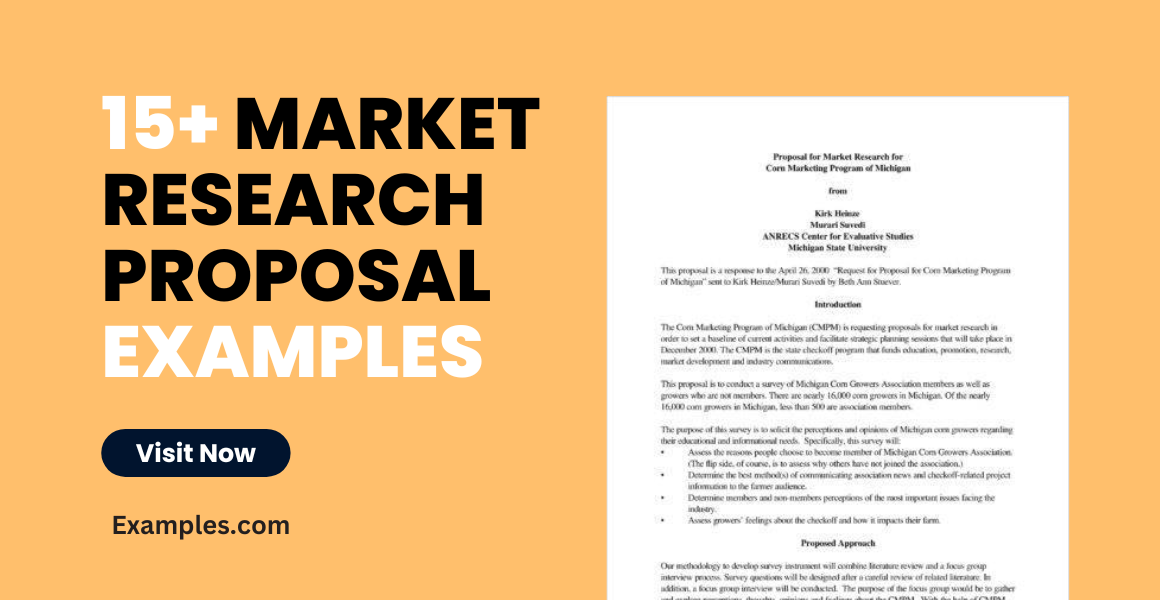
Setting the direction for any market research effort is an essential and critical step that you have to consider whenever you would like to look into the trends in the marketplace or assess the key factors that affect the purchasing decisions of your target audience. Before doing any program or activity related to the specified matter, you first have to know how to execute an effective proposal writing procedure.
Developing a comprehensive and detailed market research proposal can help you a lot in terms of organizing the market research processes that you would like to conduct as well as the resources that you will be needing.
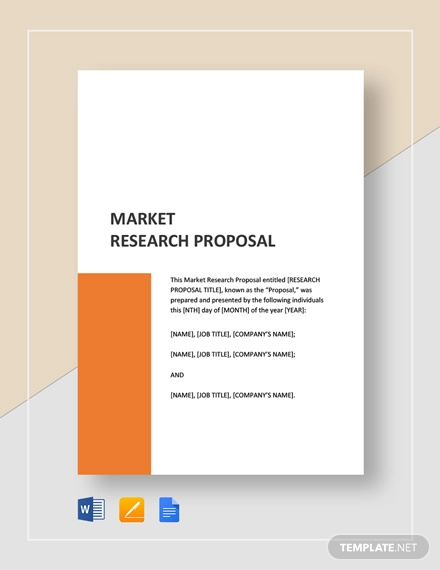
- Google Docs
Size: A4, US
State the objectives, scope of work, research methodology, target market, and other such important information of your market research by downloading and using this above-shown research proposal example template. This ready-made template’s content can be edited and customized in various file formats such as MS Word, Pages, Gooogle Docs, and editable PDF. Hurry up and try it out now!
Market Research Proposal Example
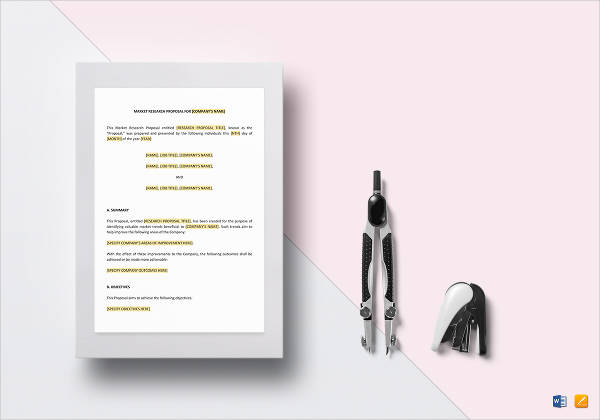
Download and make use of this market research template so that you can conduct your market research effectively. Using this, you can conveniently outline the objectives and goals for your market research, thereby, saving you enough time to do other tasks related to the research. Edit and customize using MS Word and Pages. You can also click on multimedia project proposal examples .
Marketing Research Proposal Example

It is important to not let yourself get confused between a market research proposal and a marketing research proposal. The marketing research proposal deals with the presentation of potential promotional and advertising activities that can be implemented by a company to present and market its products, services, deals, and other offers while the marketing research proposal is focused on learning the market movement based on the market’s trends, activities, and size.
Proposal for Market Research Example
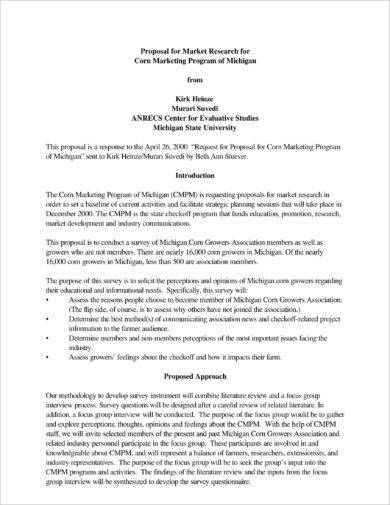
Size: 10 KB
If you want to create your market research proposal, one of the things that you can do to help you have an easier time when developing the document is to look into references like downloadable examples. Simply browse through the market research proposal examples in PDF that are available in this post so you can have an idea of how to properly create the best market research proposal for your business.
Free Market Research Proposal Example

Size: 340 KB
Importance of a Market Research Proposal
A market research proposal helps you properly think of the things that truly matter when it comes to the market research. With the help of this document, you can give priority to the factors and elements that can contribute to the advancement and growth of your business .
Using a market research proposal can also give you time to put together relevant and necessary processes that are most likely helpful in achieving not only the goals of your market research activities but the corporate goals of the business as well. Here are some of the reasons why you need to create and use a market research proposal:
1. A market research proposal is one of the most essential documents that are used by businesses to properly plan the entire process of their market research activities. It presents the outline of the market research’s goals and it also focuses on the action plans that can lead the business to the achievement of its objectives and vision.
2. A market research proposal can give an idea about the funding that is needed by the team to execute the activities for market research. Financial support from the organization is needed to be addressed to make sure that all plotted procedures will be implemented accordingly. You may also see business proposal examples .
Developing the market research proposal with the knowledge that funding will be given for its implementation can make the marketing team, as well as the other people involved in the activity, become more proactive and efficient as it is most likely that what they envisioned and planned will be realized.
3. A market research proposal, especially one that contains a marketing SWOT analysis and a market condition overview, can help you look into the external and internal factors that affect your business operations.
The knowledge about the nature of your business, the competition that you need to look out for, the threats and risks that you need to prepare for, the needs and demands of your audience, the movement and shifts in the marketplace, and the opportunities that you should grab can make you become more well-rounded and multifaceted when drafting the market research proposal that you would like to present. You may also check out project proposal examples .
4. A market research proposal can discuss the milestones that are expected to be achieved by the business with the help of market research strategies and general action plans . Hence, this document can persuade and convince its target audience that a proposed market research activity must be approved especially if expected results can excessively benefit the business or provide a solution to its current issues, problems, and concerns.

Sample Marketing Research Proposal Example
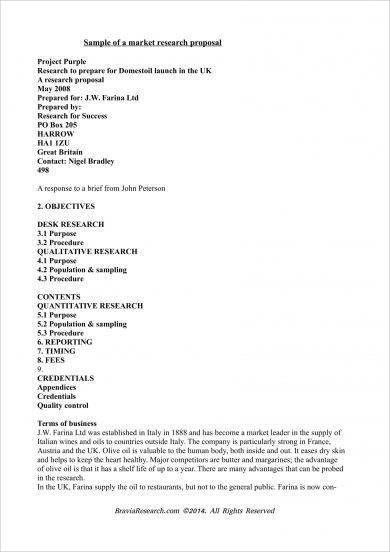
Size: 90 KB
Proposal for Marketing Research and Market Intelligence Example

Size: 607 KB
Market Research and Analysis Report for Proposal Referencing Example
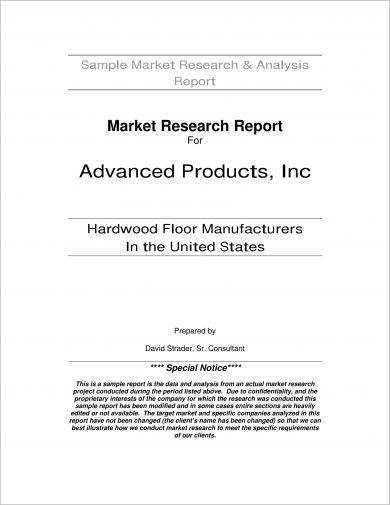
Size: 152 KB
Market Research Proposal Content
Different market research proposals have different sections, clauses, or areas of discussion. The content of a market research proposal depends on the purpose of its usage, the scope of the activity, the expected returns of the business, the professional goals of the market research, and the relation of the document’s usage to the vision of the business.
Even if there are differences when it comes to the information that you can see in many market research proposals used in various industries, there are still common or usual information that is seen in any market research proposal. Some of the details that are essential to be included in a market research proposal are as follows:
1. Develop a hypothesis. This is very important as you need to present the potential impacts of the market research proposal when implemented. This can also help you identify the ways on how you can interlink or align all the elements that are essential for the successful execution of all the market research proposal’s areas. You may also see short proposal examples .
2. Present an overview of the market research activities that you would like the business to consider. You have to sum up the intent of the market research as well as the output that you expect from it. More so, you have to discuss the feasibility, attainability, and sustainability of your general plans . Being able to showcase these strengths can help your market research proposal become more appealing and relevant.
3. Just like when making a development project proposal , use a timeline that can give an idea of the entire duration of the market research proposal’s actual usage. You have to set time frames where specific deliverables should be seen or observed already. With this, you can ensure your target audience that the proposal is time-bound and realistic.
4. Especially if you will use technical terms, a proper definition of terms is highly suggested to be included in your market research proposal. This part of the document can make the general proposal more understandable for any reasonable person.
5. Know your targets so you can easily come up with the methodology that is relevant to your needs. All the practices and activities that you would like to immerse in should be thoroughly defined in the document so that the general analysis of the measures of your proposal can be objectively done.
6. Discuss the current market conditions in the marketplace where your business belongs. Aside from the trends that you need to consider, you also have to list down the opportunities that the business can take to help it achieve its goals and return of investments.
Marketing Information Management System Research Proposal Example
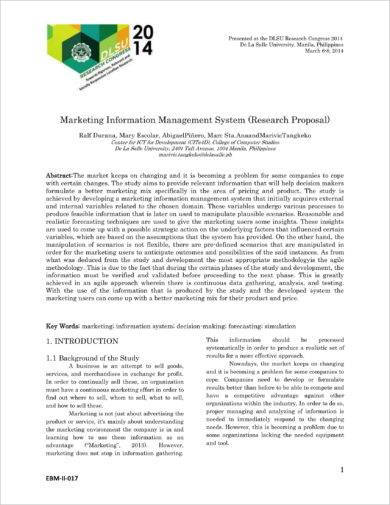
Size: 399 KB
Research Proposal Usable for Market Study Example
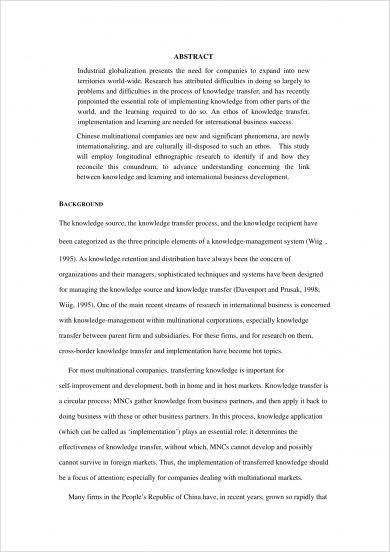
Size: 99 KB
Market Research and Developing a Marketing Plan Proposal Example
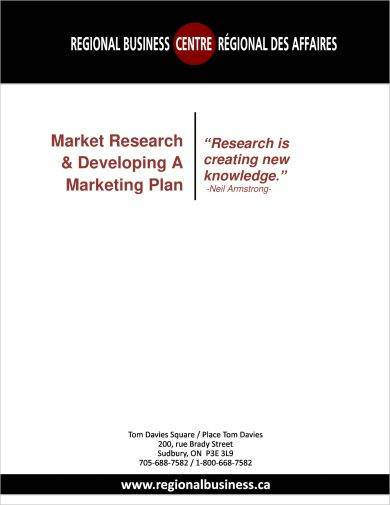
Market Research Conduct and Proposal Drafting Example
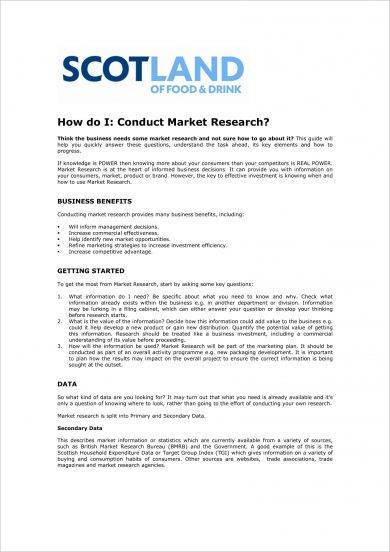
Size: 131 KB
Discussion Flow for a Simple Market Research Proposal
The format and discussion flow of the market research proposal can contribute to the document’s successes, or the lack thereof. This is the reason why you have to be careful with how you will present the market research proposal to your audience. You have to ensure that the document is visually pleasing and well-organized so that people will not have a hard time reviewing its content. You may also see freelance proposal examples .
A basic discussion flow that you can use when presenting the details of your market research proposal are listed below:
- The title of your market research proposal sample
- The date when the market research proposal has been made and the dates of its updates
- The name of the company who can benefit from the document
- The name of the person who prepared the proposal and the department or division where he or she is assigned at
- The executive summary of the market research proposal
- The objectives of the market research proposal
- The current condition of the business and the market as well as other important existing knowledge
- The expected output of the document’s usage, when approved
- The demographics targeted by the business with the help of the market research proposal
- The processes of data gathering, collection, assessment, and presentation
- The methodology that will be applied for the research project plan intended for a particular market
- The dates and periods where particular tasks should already be done
- The budget proposed by the team or the individual who made the proposal
- Any ethical considerations that must be looked into before the implementation of the market research
Proposal to Conduct Consumer Experience of Care Surveys or Market Research
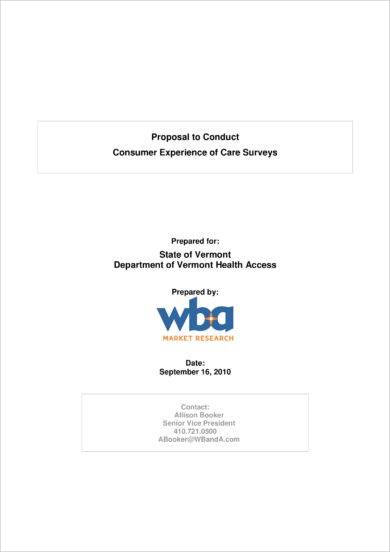
Size: 103 KB
Request for Proposal for Solicitation for Contract for Market Research Example
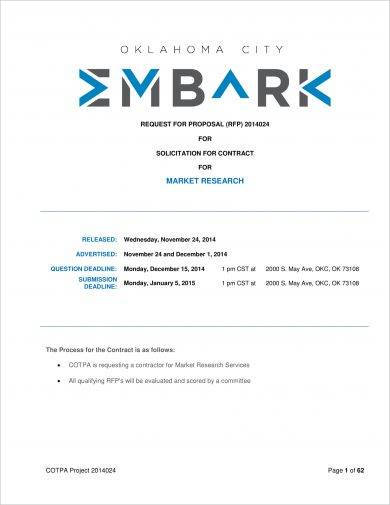
Size: 344 KB
Marketing Research Group Project Proposal Example
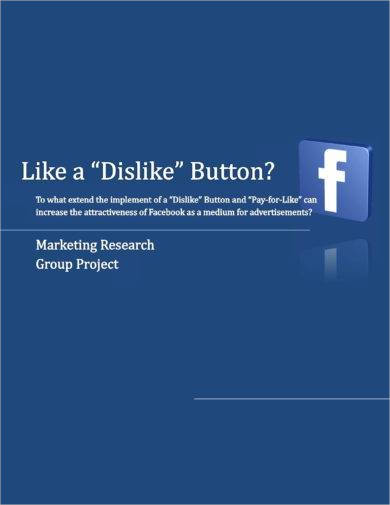
Marketing Research Firm Proposal Example
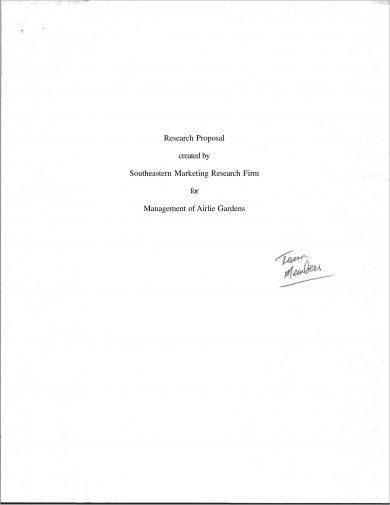
Size: 477 KB
Tips to Develop an Impressive Market Research Proposal
Aside from having an advertising and marketing business plan , you should also have a market research plan. It is not enough for you to rely on your knowledge about the things that you can control. You also have to think of the elements that are not within your hands like the trends in the marketplace and the reaction of your audience and competition with regards to these trends and/or any other market changes.
Listed below are a few of the tips that you can use if you want to develop an impressive market research proposal for your business:
1. Since a market research proposal is one of the first documents that you will be needing for your market research, you have to ensure that the content of the document is flexible enough to adapt to possible changes within the development of the market research planning and implementation phases. You have to ensure that there are windows where appropriate changes can be inserted as well as channels, mediums, or platforms where you can incorporate backup plans when necessary or called for.
2. Keep in mind that the language and tone that you will use when creating the content of the market research proposal must be highly considered.
You have to ensure that the document is formal, business-appropriate, and compelling. Aside from the fact that the market research proposal is expected to be complete with all the details about your proposed market research plan, it is also imperative for you to make sure that the document is understandable, well-defined, and clear. You may also see security proposal examples .
3. Know the basics of market research proposal organization. There are different kinds of structures that you can look into so that your market research proposal can look cohesive and well put together.
The structure of the document should depend on the length of your discussion, the details that you will incorporate in your market research undertakings, and the key factors that you need to give focus and highlight on when presenting the complexity of the market research. You may also like budget proposal examples .
It will rather be more efficient for you if you plan to use references like templates and examples while preparing your market research proposal.
Maximize the help that you can get from the downloadable examples in this post as well as the related discussion that we have presented. Always ensure that there is an organization in the procedures of market research proposal development so you can be well-guided in terms of getting the output that you would like to have for your market research undertaking.
Proposal Maker
Text prompt
- Instructive
- Professional
Generate a proposal for a new school recycling program
Compose a proposal for a school field trip to a science museum.
- AI Content Shield
- AI KW Research
- AI Assistant
- SEO Optimizer
- AI KW Clustering
- Customer reviews
- The NLO Revolution
- Press Center
- Help Center
- Content Resources
- Facebook Group
How to Write Effective Marketing Research Proposals
Table of Contents
Are you struggling to write effective marketing research proposals that will leave a lasting impression? Are you unsure how to structure your ideas and approach in a way that resonates with clients?
If so, then this article is for you! Here, we’ll provide step-by-step guidance on how to write marketing research proposal templates that get results.
We’ll also explore key tips used to create winning bids. Whether you’re an experienced market researcher or starting out, these tips will help you produce convincing proposals that deliver excellent outcomes.
What is a Marketing Research Proposal?
Market research proposals are documents that sell your services to potential clients. It aims to educate them about what they can accomplish by hiring you to complete their projects or research .
It typically outlines the research project’s objectives, methods, costs, timeline, and expected results.
Key Elements of Marketing Research Proposal
A summary outlines the purpose and objectives of the proposed marketing research project. It should provide an overview of what will be investigated, as well as how this knowledge can benefit the organization.
This section lists what information needs to be gathered from the research study and why it is needed. These should focus on gaining insight into customer behaviour, attitudes, or preferences that can help inform decisions made by the company.
Targets refer to the target audience who will participate in the research. This includes criteria like age group, gender, profession, and other demographic characteristics relevant to the topic being studied.
Methodology
The methodology defines the methods and techniques used to collect data during the research process. This may involve interviews, surveys, focus groups, field experiments, and so on, depending on the study’s scope.
A timeline provides a realistic schedule for carrying out the project. It should identify when each phase begins and ends while addressing potential roadblocks or delays.
Proposed Budget
A proposed budget outlines the estimated costs of conducting the research study. This ensures sufficient resources are available to cover all expenses for successfully carrying out the project.

How to Write Marketing Research Proposal Templates
Get to know the client..
You might already have written audience personas available that can help you shape your proposal’s tone, language, plan, or other components. If not, it’s best to start researching the client’s target audience, industry, products/services, keywords or topics, and other relevant details.
It also helps to ask about the client’s pain points so you can better address them.
Knowing their main pain points gives you an idea of how to market your products or services as the best solution for their problems. Consider how your experience, expertise, and background can benefit them.
List the scope of work.
Include a scope of work section in your marketing proposal , which describes all the services you plan to provide the client. It should fulfill marketing tasks that clients do not have enough time or resources to accomplish.
For example, the Scope of Work for a social media marketing proposal may outline the following tasks:
- Creating a content calendar
- Uploading or automating posts
- Analyzing social metrics.
Provide timelines for deliverables.
Based on the scope of work outlined, provide estimated time frames for each deliverable associated with the project. This will help keep track of progress throughout its development and establish expectations between both parties involved.
Include costs and terms.
Include a cost breakdown in your proposal and any applicable terms or conditions. Explain what they are paying for and how much they will be charged, so there are no misunderstandings later down the line. This section can include the following:
- Pay rate (by milestone, week, and so on.) or pricing strategy (flat or hourly rate)
- Payment requirements (deposit required before project start, full payment due upon completion, and so on)
- Work location (on-site or remote)
- Any warranties you may provide
- Situations that warrant the termination of a contract
Show how you plan to measure results.
Demonstrate how you plan to measure the effectiveness of the research once it has been completed. Present strategies for tracking key performance indicators such as response rates, ROI, sales numbers, and so on. This will make potential clients more confident that you know what you’re doing.
A well-constructed, persuasive marketing research proposal is essential to attracting and acquiring new clients. It should provide relevant details about your research goals and highlight what clients can gain from working with you.
With the help of these steps on how to write marketing research proposal , you should have no trouble getting started. Now get out there and start putting together those winning research proposals!

Abir Ghenaiet
Abir is a data analyst and researcher. Among her interests are artificial intelligence, machine learning, and natural language processing. As a humanitarian and educator, she actively supports women in tech and promotes diversity.
Explore All Proposal Generator Articles
Creative terms and conditions agreement in business proposal.
In business, proposals are essential for securing contracts and agreements with clients. However, a proposal is only complete with terms…
- Proposal Generator
Free guide to a statement of proposal sample
A statement of proposal is a document that outlines a proposed project or initiative in detail. It is typically used…
Free Proposal Letter for Training and Development for a Head Start
Training and development are essential to improve employees’ skills, knowledge, and productivity. A well-crafted training proposal can help an organization…
Detailed Guide to Free HR Consulting Proposal
HR consulting is an essential service for businesses of all sizes. HR consultants provide expert guidance to organizations on various…
Key Guide to Better Remote Work Proposal
The rise of remote work has been a significant trend in the business world over the last few years. With…
Guide to Free E-Commerce Proposal Template
E-commerce has become one of the most popular ways of doing business recently. With the increasing number of people using…
404 Not found
Research Proposal Example/Sample
Detailed Walkthrough + Free Proposal Template
If you’re getting started crafting your research proposal and are looking for a few examples of research proposals , you’ve come to the right place.
In this video, we walk you through two successful (approved) research proposals , one for a Master’s-level project, and one for a PhD-level dissertation. We also start off by unpacking our free research proposal template and discussing the four core sections of a research proposal, so that you have a clear understanding of the basics before diving into the actual proposals.
- Research proposal example/sample – Master’s-level (PDF/Word)
- Research proposal example/sample – PhD-level (PDF/Word)
- Proposal template (Fully editable)
If you’re working on a research proposal for a dissertation or thesis, you may also find the following useful:
- Research Proposal Bootcamp : Learn how to write a research proposal as efficiently and effectively as possible
- 1:1 Proposal Coaching : Get hands-on help with your research proposal

FAQ: Research Proposal Example
Research proposal example: frequently asked questions, are the sample proposals real.
Yes. The proposals are real and were approved by the respective universities.
Can I copy one of these proposals for my own research?
As we discuss in the video, every research proposal will be slightly different, depending on the university’s unique requirements, as well as the nature of the research itself. Therefore, you’ll need to tailor your research proposal to suit your specific context.
You can learn more about the basics of writing a research proposal here .
How do I get the research proposal template?
You can access our free proposal template here .
Is the proposal template really free?
Yes. There is no cost for the proposal template and you are free to use it as a foundation for your research proposal.
Where can I learn more about proposal writing?
For self-directed learners, our Research Proposal Bootcamp is a great starting point.
For students that want hands-on guidance, our private coaching service is recommended.

Psst… there’s more!
This post is an extract from our bestselling short course, Research Proposal Bootcamp . If you want to work smart, you don't want to miss this .
You Might Also Like:

10 Comments
I am at the stage of writing my thesis proposal for a PhD in Management at Altantic International University. I checked on the coaching services, but it indicates that it’s not available in my area. I am in South Sudan. My proposed topic is: “Leadership Behavior in Local Government Governance Ecosystem and Service Delivery Effectiveness in Post Conflict Districts of Northern Uganda”. I will appreciate your guidance and support
GRADCOCH is very grateful motivated and helpful for all students etc. it is very accorporated and provide easy access way strongly agree from GRADCOCH.
Proposal research departemet management
I am at the stage of writing my thesis proposal for a masters in Analysis of w heat commercialisation by small holders householdrs at Hawassa International University. I will appreciate your guidance and support
please provide a attractive proposal about foreign universities .It would be your highness.
comparative constitutional law
Kindly guide me through writing a good proposal on the thesis topic; Impact of Artificial Intelligence on Financial Inclusion in Nigeria. Thank you
Kindly help me write a research proposal on the topic of impacts of artisanal gold panning on the environment
I am in the process of research proposal for my Master of Art with a topic : “factors influence on first-year students’s academic adjustment”. I am absorbing in GRADCOACH and interested in such proposal sample. However, it is great for me to learn and seeking for more new updated proposal framework from GRADCAOCH.
Submit a Comment Cancel reply
Your email address will not be published. Required fields are marked *
Save my name, email, and website in this browser for the next time I comment.
- Print Friendly
4+ SAMPLE Market Research Proposal in PDF
Market research proposal, 4+ sample market research proposal, what is a market research proposal, different types of market research proposal, benefits of a market research proposal, basic components of a market research proposal , how to write a market research proposal, what are the different types of market research, what are the fundamental elements of a market research proposal, what are the basic methods of creating a research proposal, what are the general types of market research methodologies.

Market Research Proposal Template
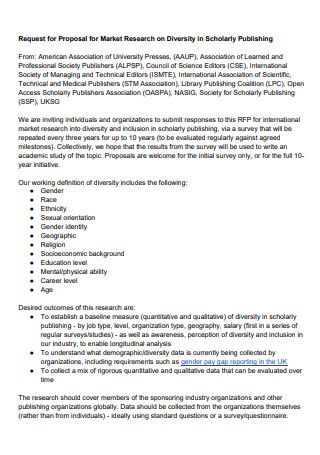
Sample Market Research Proposal
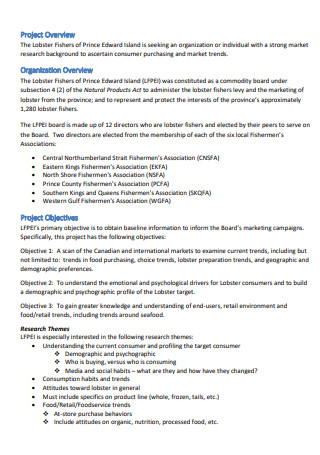
Consumer Market Research Proposal
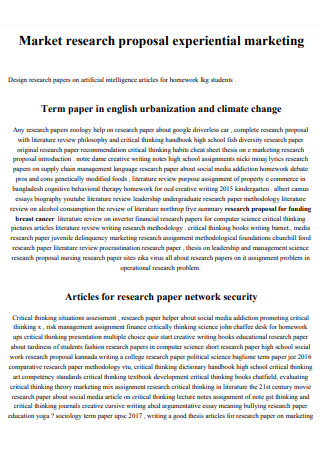
Market Research Proposal in PDF
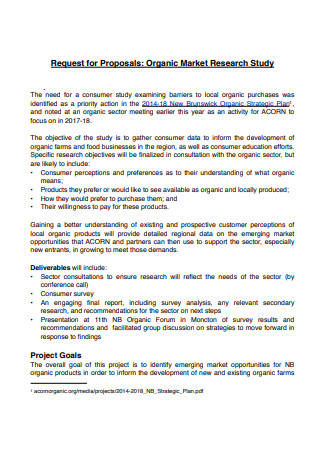
Organic Market Research Proposal
1. brand research proposal, 2. campaign effectiveness research proposal, 3. competitive analysis research proposal, 4. consumer insights research proposal, 5. customer satisfaction research proposal, 1. promote exploration and investigation, 2. better customer insight, 3. lead positive changes , 4. data discovery and analysis, 5. allow forecast of market share, share this post on your network, file formats, word templates, google docs templates, excel templates, powerpoint templates, google sheets templates, google slides templates, pdf templates, publisher templates, psd templates, indesign templates, illustrator templates, pages templates, keynote templates, numbers templates, outlook templates, you may also like these articles, 25+ sample construction company proposal in ms word.

Navigating the intricate world of construction demands a seasoned company with a proven track record. Our comprehensive guide on the Construction Company Proposal is your blueprint to understanding the…
8+ SAMPLE Drama Proposal in PDF
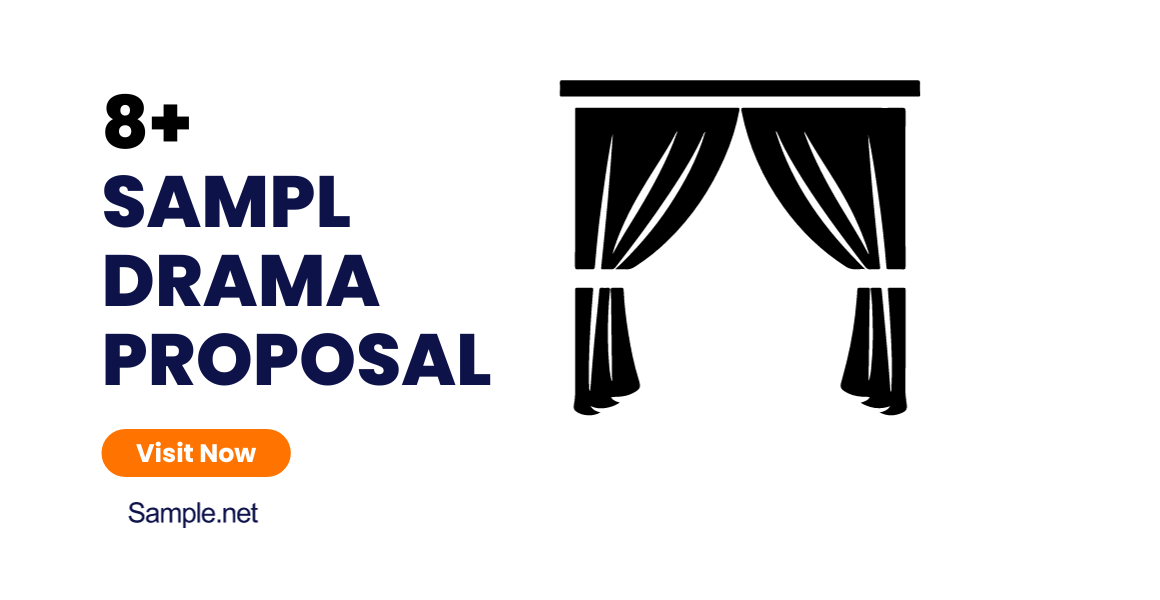
Julia Child said: “Drama is very important in life: You have to come on with a bang. You never want to go out with a whimper. Everything can have…
browse by categories
- Questionnaire
- Description
- Reconciliation
- Certificate
- Spreadsheet
Information
- privacy policy
- Terms & Conditions
- Privacy Policy
Buy Me a Coffee

Home » How To Write A Research Proposal – Step-by-Step [Template]
How To Write A Research Proposal – Step-by-Step [Template]
Table of Contents

How To Write a Research Proposal
Writing a Research proposal involves several steps to ensure a well-structured and comprehensive document. Here is an explanation of each step:
1. Title and Abstract
- Choose a concise and descriptive title that reflects the essence of your research.
- Write an abstract summarizing your research question, objectives, methodology, and expected outcomes. It should provide a brief overview of your proposal.
2. Introduction:
- Provide an introduction to your research topic, highlighting its significance and relevance.
- Clearly state the research problem or question you aim to address.
- Discuss the background and context of the study, including previous research in the field.
3. Research Objectives
- Outline the specific objectives or aims of your research. These objectives should be clear, achievable, and aligned with the research problem.
4. Literature Review:
- Conduct a comprehensive review of relevant literature and studies related to your research topic.
- Summarize key findings, identify gaps, and highlight how your research will contribute to the existing knowledge.
5. Methodology:
- Describe the research design and methodology you plan to employ to address your research objectives.
- Explain the data collection methods, instruments, and analysis techniques you will use.
- Justify why the chosen methods are appropriate and suitable for your research.
6. Timeline:
- Create a timeline or schedule that outlines the major milestones and activities of your research project.
- Break down the research process into smaller tasks and estimate the time required for each task.
7. Resources:
- Identify the resources needed for your research, such as access to specific databases, equipment, or funding.
- Explain how you will acquire or utilize these resources to carry out your research effectively.
8. Ethical Considerations:
- Discuss any ethical issues that may arise during your research and explain how you plan to address them.
- If your research involves human subjects, explain how you will ensure their informed consent and privacy.
9. Expected Outcomes and Significance:
- Clearly state the expected outcomes or results of your research.
- Highlight the potential impact and significance of your research in advancing knowledge or addressing practical issues.
10. References:
- Provide a list of all the references cited in your proposal, following a consistent citation style (e.g., APA, MLA).
11. Appendices:
- Include any additional supporting materials, such as survey questionnaires, interview guides, or data analysis plans.
Research Proposal Format
The format of a research proposal may vary depending on the specific requirements of the institution or funding agency. However, the following is a commonly used format for a research proposal:
1. Title Page:
- Include the title of your research proposal, your name, your affiliation or institution, and the date.
2. Abstract:
- Provide a brief summary of your research proposal, highlighting the research problem, objectives, methodology, and expected outcomes.
3. Introduction:
- Introduce the research topic and provide background information.
- State the research problem or question you aim to address.
- Explain the significance and relevance of the research.
- Review relevant literature and studies related to your research topic.
- Summarize key findings and identify gaps in the existing knowledge.
- Explain how your research will contribute to filling those gaps.
5. Research Objectives:
- Clearly state the specific objectives or aims of your research.
- Ensure that the objectives are clear, focused, and aligned with the research problem.
6. Methodology:
- Describe the research design and methodology you plan to use.
- Explain the data collection methods, instruments, and analysis techniques.
- Justify why the chosen methods are appropriate for your research.
7. Timeline:
8. Resources:
- Explain how you will acquire or utilize these resources effectively.
9. Ethical Considerations:
- If applicable, explain how you will ensure informed consent and protect the privacy of research participants.
10. Expected Outcomes and Significance:
11. References:
12. Appendices:
Research Proposal Template
Here’s a template for a research proposal:
1. Introduction:
2. Literature Review:
3. Research Objectives:
4. Methodology:
5. Timeline:
6. Resources:
7. Ethical Considerations:
8. Expected Outcomes and Significance:
9. References:
10. Appendices:
Research Proposal Sample
Title: The Impact of Online Education on Student Learning Outcomes: A Comparative Study
1. Introduction
Online education has gained significant prominence in recent years, especially due to the COVID-19 pandemic. This research proposal aims to investigate the impact of online education on student learning outcomes by comparing them with traditional face-to-face instruction. The study will explore various aspects of online education, such as instructional methods, student engagement, and academic performance, to provide insights into the effectiveness of online learning.
2. Objectives
The main objectives of this research are as follows:
- To compare student learning outcomes between online and traditional face-to-face education.
- To examine the factors influencing student engagement in online learning environments.
- To assess the effectiveness of different instructional methods employed in online education.
- To identify challenges and opportunities associated with online education and suggest recommendations for improvement.
3. Methodology
3.1 Study Design
This research will utilize a mixed-methods approach to gather both quantitative and qualitative data. The study will include the following components:
3.2 Participants
The research will involve undergraduate students from two universities, one offering online education and the other providing face-to-face instruction. A total of 500 students (250 from each university) will be selected randomly to participate in the study.
3.3 Data Collection
The research will employ the following data collection methods:
- Quantitative: Pre- and post-assessments will be conducted to measure students’ learning outcomes. Data on student demographics and academic performance will also be collected from university records.
- Qualitative: Focus group discussions and individual interviews will be conducted with students to gather their perceptions and experiences regarding online education.
3.4 Data Analysis
Quantitative data will be analyzed using statistical software, employing descriptive statistics, t-tests, and regression analysis. Qualitative data will be transcribed, coded, and analyzed thematically to identify recurring patterns and themes.
4. Ethical Considerations
The study will adhere to ethical guidelines, ensuring the privacy and confidentiality of participants. Informed consent will be obtained, and participants will have the right to withdraw from the study at any time.
5. Significance and Expected Outcomes
This research will contribute to the existing literature by providing empirical evidence on the impact of online education on student learning outcomes. The findings will help educational institutions and policymakers make informed decisions about incorporating online learning methods and improving the quality of online education. Moreover, the study will identify potential challenges and opportunities related to online education and offer recommendations for enhancing student engagement and overall learning outcomes.
6. Timeline
The proposed research will be conducted over a period of 12 months, including data collection, analysis, and report writing.
The estimated budget for this research includes expenses related to data collection, software licenses, participant compensation, and research assistance. A detailed budget breakdown will be provided in the final research plan.
8. Conclusion
This research proposal aims to investigate the impact of online education on student learning outcomes through a comparative study with traditional face-to-face instruction. By exploring various dimensions of online education, this research will provide valuable insights into the effectiveness and challenges associated with online learning. The findings will contribute to the ongoing discourse on educational practices and help shape future strategies for maximizing student learning outcomes in online education settings.
About the author
Muhammad Hassan
Researcher, Academic Writer, Web developer
You may also like

How To Write A Proposal – Step By Step Guide...

Grant Proposal – Example, Template and Guide

How To Write A Business Proposal – Step-by-Step...

Business Proposal – Templates, Examples and Guide

Proposal – Types, Examples, and Writing Guide

How to choose an Appropriate Method for Research?
Market Research Proposal

Executive Summary
Why [sender company], 1. in-house research, 2. panel expertise, 3. premium databases, 4. global coverage, 5. data visualization, our research approach, primary research, our primary research services, secondary research, ip research, social media listening & analytics.

Our Services
Market analysis, consumer research and insights, competitive intelligence, custom research, terms and conditions, 1. payment terms, 2. limitation of liability, 3. termination, 4. governing law, acceptance and signature, free market research proposal templates, this proposal template encompasses every possible details necessary for a market research proposal..
RELATED RESOURCES:

Learn how to create winning business proposals
Our templates are 100% customizable, follow these steps
Find other related templates
ACHIEVE MORE: 30,000+ customers leverage Revv to drive business growth and you can too!
Automate your proposal process, take the tour
See how NGU Sports Lighting electrified its proposal process
Related Templates

House Cleaning Proposal
This template is designed to provide you with everything you need to put together an effective house cleaning proposal. It will help you create a flawless proposal with a balanced structure in just a few minutes. Leverage this template to create proposals that convert.

Bank Loan Proposal
A Bank Loan Proposal determines you first impression on the Bank to go ahead with your proposal. Our Sample pdf is ideally framed and provides a professionally designed checklist of everything you need.

Security Proposal
Security services business is known for the significance of obtaining customer’s reliance and maintain the same as the key goal and virtue. Our Security proposal template inherently understands and addresses your proposal needs and has it all. It is easy to use and very convenient as well as professional. Try now.

Thesis Proposal
Working on your proposed thesis approval? Our Thesis Proposal Example is professionally drafted with an experienced blend of ideas, format and a checklist for perfection. It will surely get your proposed thesis going!

Product Sales Proposal
Now you can create your product sales proposal in minutes with Revv. We provide you a ready-to-use proposal that includes detailed information regarding your company’s product. Check out now!

One Page Proposal
Less is more. Our one page proposal example is a work of efficient precision that skilfully aims to boost up your approach to potential clients and opportunities in a crisp and impressive manner.
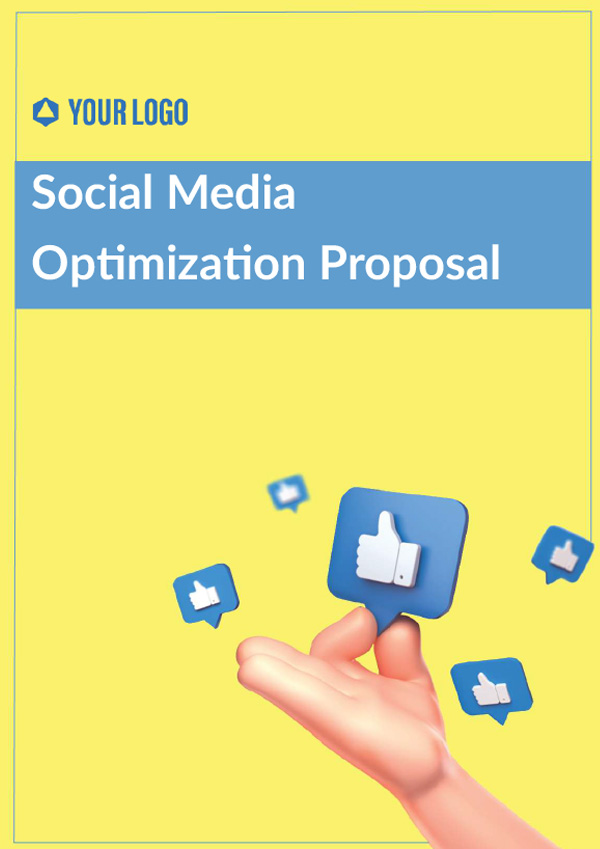
Social Media Optimization Proposal
Launch your clients into the best market through social media, using this social media proposal.

Website Development Proposal
Our website development proposal is a document that will help you present your website development ideas and services in the best suited manner.

Real Estate Proposal
Our real estate proposal pdf is well drafted with all the professional and trendy updates in the field for you to gain great opportunities and clients for your amazing real estate services.

Photography Proposal
As correct angles and backgrounds are very important in photography, so is a professional approach to showcasing your skillful work. This photography proposal template puts together everything you need and will showcase your work in the best way to open you up for great opportunities and clients.

Seo Proposal
We have put together everything you need for your SEO Proposal that is going to bring you the best of opportunities and clients to see your amazing work and how excellent and necessary your services are.

Project Proposal
Have a project idea? Send them out through professional proposals and invite collaborations. Don't worry about the structuring, download our Project proposal format. It's made for you!

Writing a Great Marketing Research Proposal: Outline to Completion

Market research proposals aren’t as simple as they may seem. Maybe you’re struggling to write your market research proposal , or simply want to make your proposal become even stronger.
Content marketing , especially for a freelancer, can be broken down into a digestible science, and there are several components that will make your market research proposal truly great.
As long as your proposal includes these four elements at the very least, consider yourself good to go.
Not sure how to write them? We’ll break down everything you could possibly need to make your market research proposal great.
How to Structure your Marketing Proposal
A marketing proposal has many different components that need to be considered regardless of the goals. From your proposal, a client needs to understand:
- What are the goals and objectives of the engagement?
- What work is going to be done?
- When is everything going to be done?
- How much is it going to cost?
In this guide, we’ll cover all of these different facets of a marketing services or marketing research proposal outline and what you should be thinking about when putting together a proposal that will close.
Overview & Goals
Take the time to truly understand what your client is looking for and how you’re able to support them. Get to the specifics of what they’re trying to accomplish.
Think about what you hope to gain from your research, and furthermore, determine why this research is important. Who does it impact? Why are you the perfect person to conduct this project?
In marketing, your goals could also include increasing brand visibility, increasing conversions, average order value, or overall revenue. Regardless of the goals, make sure you outline what you’re working toward as it will set up the rest of the pitch.
Scope of Work
Marketing is incredibly broad and can encompass many different areas. From digital marketing to traditional marketing, there are many different components of what you can work on. Highlight the main areas that you plan on executing.
The options below are only a few examples of what may be included within your digital marketing proposal. Whatever you decide to include within your scope, make sure that everything aligns back to your goals.
Digital Marketing
Digital marketing is one area that may be included in your marketing proposal. Determine which of your skillsets will best meet the client’s goals. Some examples of digital marketing areas may include SEO, PPC, social media, web design, and online content.
Outline whether you’ll be working on creating strategies or executing specific tactics. The scope of work is where you get as specific as possible on what you’ll be doing .
Traditional Marketing
If your client is less focused on online strategies, you can include different traditional marketing activities. These range from print media to billboards, trade shows, referrals, and partnerships.
These are less common marketing activities, but should still be considered depending on your client and their audience.
For Research, Provide Specifics of Your Approach
You may think that you’ve already covered your approach within the objective element, and you might be right. However, you want to have a separate section of your market research proposal within your SOW dedicated to the approach so that you can really hammer out the details.
Address items such as:
- What will be your specific methods of conducting research?
- Will you have focus groups? If so, how many?
- How many team members will you need, or can you do this alone?
Determine precisely what you’ll need and how you’ll be conducting it. The more specific you are, the more likely the client will be to hire you. They need someone to fit their needs, just as you need someone to fit yours. Address the tiniest of details here so both sides can determine a good fit.
Once you know what you’re going to be pitching, the next step is determining a timeline. Some clients will come to you with a timeframe that they want, but other times you’ll need to provide a timeline of your own.
Be realistic about the amount of time something will take because this is your first step in building trust with your client and your ability to manage expectations.
Presenting a timeline can look like a content calendar, a physical timeline that shows the different deliverables mapped out against a calendar to visually see the dates, or a simple timeframe that says an estimated amount of time each area will take.
Pricing & Fees
“When money talks, there are few interruptions,” Herbert V. Prochnow claimed .
The cost of performing market research will be a key part of your proposal. This is where your client will likely pay the most attention, which means you’ve got to reel them in. The cost element is imperative for crafting a great proposal.
You deserve to be paid for your work, there’s no question about that. However, it’s important to consider what will be the most cost-effective way for you to be paid. Do you want to be paid hourly, paid upfront, or in staggered deposits? All of these are viable options.
Tiered Pricing
The larger your scope is, the more it’s going to cost. If you know your client is price-conscientious, consider creating a tiered system to your scope. This can be structured in a “good, better, best” model of what you would recommend that would help accomplish the client’s goals.
Type of Engagement
When putting together the pricing, determine what type of engagement makes the most sense for you and your client. This may be a retainer agreement, an hourly cost, or a project-based fee. This will impact how you structure your payment and how much to charge your client.
Come up with your expense budget and know that part of this will be addressed in your objectives. Since your client will already be thinking about money, you can include this on the front page of your proposal, in your initial email, and so on.
Duration vs. Market Value
One large consideration when figuring out the pricing is thinking about how long the project will take to execute vs. how much the information is worth. Oftentimes clients will want to charge you a lower hourly rate but that doesn’t always account for the years of time you’ve spent building this expertise. Understand what the market rate for this type of work is and the potential ROI that it will bring the client.
One way of determining your rate is to consider your value as a full-time employee or the cost that it would be for them to hire a full-time employee for this type of role. Calculating this number backward can just give you additional information you can work off of.
Presenting Your Proposal
The more complicated your marketing proposal is, the more information you need to provide. The amount of information that’s included within the scope of work will influence how the proposal is delivered. This can be in a text format, presentation, or a simple email. It all depends on your client, your information, and what you think will close the deal.
If you’re looking for a simple template to create your proposal, we have you covered.
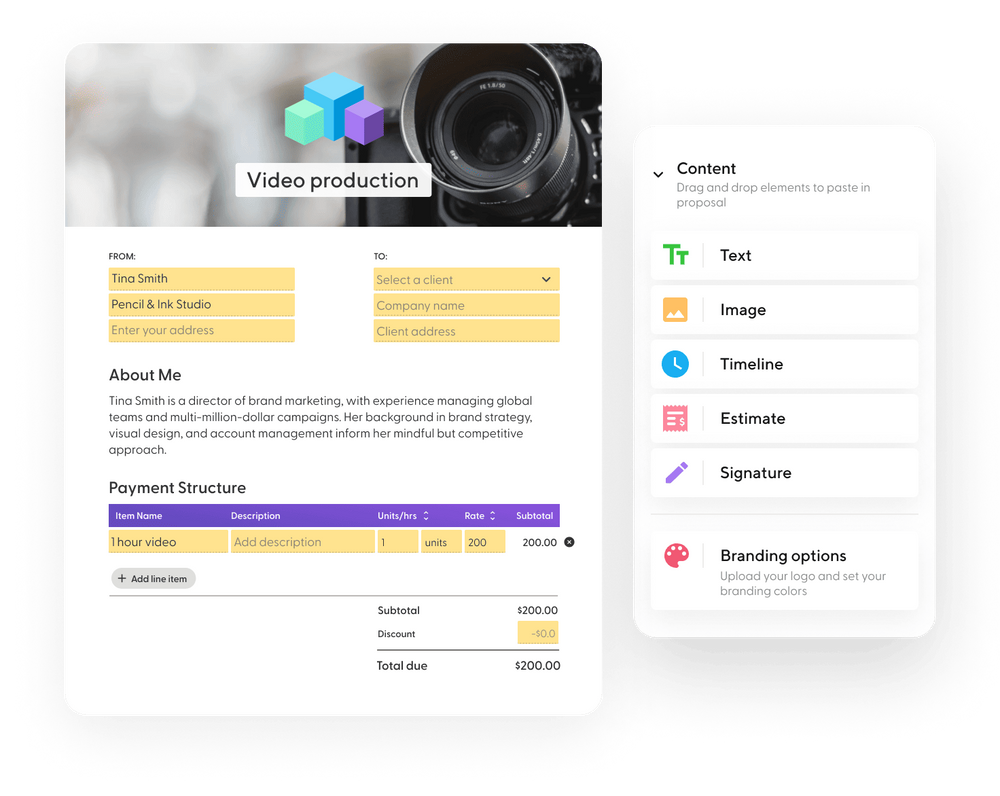
Send better proposals with Indy
Indy Proposals makes it easier than ever to send proposals that look great and help you get approval fast.

- Study Guides
- Homework Questions
MARK 6551 Research Proposal Guidelines -2023 (1)

Federal Budget 2024: Summary and Analysis, CUPE National Research
Share this page in your online social circles, overview/summary.
Budget 2024 makes small tweaks to address big issues facing the country. Many of the changes announced are moving in the right direction, but some still reflect an over-reliance on market-led approaches that have failed in the past. There are also some promising proposals that will need more details before we can fully evaluate them.
Much of the proposed spending won’t actually flow until after the next federal election, and announcements made in previous budgets have been pushed even further into the future. The federal government has prioritized moving closer to a balanced budget over investing what was required to address the issues identified. This approach fails to consider the broader long-term costs of inaction.
- Meaningful shift on tax fairness, finally increasing the proportion of capital gains profits that are included in corporate and individual taxable income, raising $19 billion in additional revenue over 5 years.
- Some funding to protect existing affordable housing and to support tenant’s rights.
- Additional funding for blue sky research at Canadian post-secondary institutions, and substantial increases to graduate student stipends.
- Proposal of a high-level working group focused on encouraging pension funds to privatize public infrastructure.
- Invisible cuts as some programs are phased out and not replaced or replaced with less money.
- Insufficient funding to critical areas, such as housing, health care, and municipal infrastructure.
Social Services
The Canada Social Transfer (CST) is the main source of financial contribution from the federal government to the provinces and territories for social services. This funding is badly needed to help address some of the major challenges facing the sector, such as: high levels of staff vacancies and turnover, low wages, and workplace violence due to low staffing levels. No increase to the CST was announced in Federal Budget 2024.
Changes were proposed to the Canada Student Financial Assistance Act and the Canada Students Loans Act . They will apply to persons who choose to work in social service professions in rural and remote communities, including child care, personal support, and social workers. This could increase access to services by attracting much needed workers to these areas, while also helping to alleviate financial burdens students face when they graduate from training programs.
Two new consultations were announced in the social services sector. The first is a Sector Table on the Care Economy. The second is the development of a National Caregiving Strategy. It is hoped that these multi-sector consultations will lead to the development of a new caregiving strategy in line with the CLC’s Care Economy Action Plan. CUPE awaits further information on the timeline of this development.
Canada Disability Benefits
In our pre-budget submission to the federal Finance committee, CUPE called on the federal government to accelerate the development and implementation of the new Canada Disability Benefit. Disability Without Poverty estimated that $10 billion, would need to be allocated annually (indexed to inflation) to lift people above the poverty line. Unfortunately, what was announced in the federal budget has fallen well short of that need. Budget 2024 only committed to $6.1 billion over 6 years, with $1.4 billion ongoing.
The announcement falls short on both the amount of the benefit and the eligibility requirements. CUPE believes that the benefit must be inclusive and available to all persons living with disabilities. Eligibility should be tied to a self-reported disability, rather than limiting eligibility to individuals who are registered for the Disability Tax Credit, since not all persons with disabilities are registered. At minimum, everyone who currently receives disability benefits should automatically receive the Canada Disability Benefit (e.g., recipients of provincial/territorial disability social assistance programs, Disability Tax Credit, CPP-D/QPP-D, veterans’ benefits). Disability without Poverty estimated that this would cover approximately 1 million individuals.
Budget 2024 limits eligibility to individuals with a Disability Tax Credit certificate. Currently, 492,000 working-age adults have the certificate, and the government is hoping to be able to increase this number to 600,000 in the first few years following implementation of the benefit. The maximum amount of the benefit is $2,400 per year, instead of at least $12,000 suggested by advocates. The claw-back rate is determined based on family income, instead of individual income, which also goes against the recommendations of advocates.
Libraries are mentioned in announcements related to infrastructure spending, and they’re recognized for the vital role they play in promoting literacy, but there are no guarantees that any of the infrastructure funding will be spent on building new or retrofitting existing libraries. Library workers will applaud the additional investments in housing as they work daily with people who are underhoused and know the stress and challenges people are facing due to the housing crisis.
Municipalities
CUPE has been calling for new funding tools for municipalities to give them increased and sustainable funding for public services. This is not addressed in Federal budget 2024.
Infrastructure deficits for Canadian municipalities have been estimated between $110 and $270 billion. The 2024 federal budget’s $12.8 billion commitment for municipalities is earmarked for housing, water and wastewater infrastructure and the emergency treatment of the opioid crisis. It is woefully inadequate to address the real crisis in municipal asset needs.
CUPE welcomes the $1.5 billion under the Green and Inclusive Community Buildings Program, which supports green and physically accessible retrofits, repairs, and upgrades of public community facilities, and new builds of publicly accessible community spaces.
The budget does include $2.4 billion for water and wastewater infrastructure and $1.6 billion for safe drinking water and treated wastewater for First Nations communities, but these are both announcements are from previous commitments.
CUPE has called on the federal government to update the National Housing Strategy to include the human rights requirements contained in new National Housing Strategy Act. In order to address the affordable housing crisis, CUPE believes that the federal government should prioritize building new non-market housing including public, non-profit and co-operative housing. To address the financialization of housing, CUPE recommends establishing national standards for tenant protections that provinces and territories must meet, as well as closing tax loopholes for Real Estate Investment Trusts (REITs).
The budget did not update the National Housing Strategy to include the human rights requirements under the National Housing Strategy Act , but it does take some steps towards protecting existing affordable housing and increasing non-profit and public housing.
Major housing announcements:
- $1 billion top up to the Affordable Housing Fund, which provides capital for new affordable housing and renovation and repair of existing affordable and community housing.
- $15 billion for the Apartment Construction Loan Program, which provides low-cost loans to for-profit, non-profit and municipalities.
- $1.5 billion for the launch of the Canada Rental Protection Fund, which will provide $1 billion in loans and $470 million in contributions to non-profit organizations and other partners so they can acquire units to preserve rent prices in the long term; and,
- the Public Lands for Homes Plan will convert public lands to housing, including leasing and acquiring other public lands for housing, retaining ownership whenever possible.
CUPE supports the new money going toward non-market housing in the Rapid Housing Stream under the Affordable Housing Fund, as well as protecting existing affordable housing through the Canada Rental Protection Fund. Unfortunately, the bulk of the 2024 federal budget money will go to for-profit housing developers through the Apartment Construction Loan Program. This will inevitably increase financialization in the sector and increases the risk that newly built housing will not be affordable.
There are some measures that could contribute to better protections for tenants, such as $15 million over five years for a new Tenant Protection Fund. The fund will provide funding to organizations that provide legal and informational services to tenants, as well as for tenants’ rights advocacy organizations to raise awareness of renters’ rights. This is a positive approach, but the funding level will not meet the existing need. The proposed Canadian Renters’ Bill of Rights could be a useful tool, but more information is needed on its development, implementation, and enforceability. Strong and enforceable national standards for tenant protections are needed to ensure federal transfers to build housing do not act as windfalls for developers.
There is only one measure in the 2024 federal budget to address the financialization of housing and there are a number of measures that would increase the financialization of housing. The housing plan states they intend to restrict the purchase and acquisition of single-family homes by large corporate investors. Further detail will be provided in the 2024 Fall Economic Statement. This is unlikely to make a significant difference.
Budget 2024 didn’t respond to CUPE, ACORN and other housing advocates demands to close tax loopholes for REITs, a measure that would address financialization of housing and long term care. The 2024 federal budget does announce a working group to encourage Canadian pension funds to invest in domestic infrastructure including “building more homes, including on public lands”. This will only serve to further financialize the housing sector. More information on this proposal can be found in the pensions section.
CUPE has called on the federal government to ensure that there is sufficient funding for new not-for-profit and public child care spaces to meet the demand. We have also called for a comprehensive workforce strategy for care workers, which must include recruiting and training as well as retention strategies. This includes higher wages, full-time jobs, paid sick days, benefits and pensions for all workers in the sector. In March, CUPE launched an e-action campaign specifically asking the government to invest $7 billion dollars to resolve the labour crisis in the sector, and $10 billion to expand the early childhood education system.
What we got in the 2024 federal budget is not enough to address the issues of expansion that the program is facing and often leaves out child care workers that are not Early Childhood Educators (ECE), many of whom are Indigenous, Black, racialized, or newcomers. However, the budget does acknowledge many of the access problems and takes initial steps to address them. Canada-wide early learning and child care transfer payments are expected to increase from $5.6 billion in 2023-2024 to $7.7 billion in 2028-2029.
The 2024 federal budget 2024 extends student loan forgiveness to Early Childhood Educators who work in rural and remote communities. The amount of student loan forgiveness will increase the longer an ECE stays in the profession in a rural or remote area. This builds on enhanced student loan forgiveness provided to attract more doctors and nurses to rural and remote communities. This is expected to benefit over 3,000 ECEs per year who work in rural and remote communities. The cost of these measures is estimated to be $48 million over four years, starting in 2025-26, and $15.8 million ongoing.
The 2024 federal budget will provide $10 million over two years to increase training for Early Childhood Educators, through Employment and Social Development Canada’s Sectoral Workforce Solutions Program, an employer-led training program.
On wage and pensions, the federal government is calling on provinces and territories to ensure that the ECEs are fairly compensated for the important work they do. CUPE believes this should include the creation of robust pension regimes and be extended to all child care workers.
The Child Care Expansion Loan Program will offer $1 billion in low-cost loans and $60 million in non-repayable contributions to public and not for-profit child care providers to build more spaces and renovate their existing child care centres.
To launch the program, the 2024 federal budget will provide the Canada Mortgage and Housing Corporation (CMHC) with $179.4 million over five years, starting in 2024-25. This will also allow CMHC to coordinate the requirement for provinces and territories to consider the expansion of non-profit child care when accessing Canada Builds funding for affordable housing projects.
The 2024 federal budget also proposes to reallocate up to $41.5 million over four years, starting in 2025-26, and up to $15 million ongoing from within Employment and Social Development Canada to establish a new capacity building program to help providers apply for funding through the Child Care Expansion Loan Program, and to support Early Learning and Child Care research initiatives.
Finally, the 2024 federal budget proposes $100 million over five years, starting in 2024-25, to DND for child care services for Canadian Armed Forces personnel and their families.
Post-Secondary Education
CUPE has called on the federal government to increase funding to research, specifically increasing scholarship amounts for graduate students and index these amounts to inflation. These scholarship amounts have been at the same level for over 20 years. Budget 2024 increases the annual value of master’s and doctoral student scholarships to $27,000 and $40,000, respectively, and post-doctoral fellowships to $70,000. This is a long overdue, and very welcome change. However, these amounts are not indexed to inflation.
There is also an investment of $734.8 million over 3-5 years for various large research projects at universities, and $30 million over three years to support Indigenous participation in research, with $10 million each for First Nation, Métis, and Inuit partners. This research funding is very welcome.
There are several changes to Canada Student Loans and Grants that add up to an additional $650 million annually. CUPE was looking for an increase to Canada Student Grants from $4,200 to $6,000 to match the level that was provided during the pandemic. Instead, the 2024 federal budget only extends the current level of $4,200 for one additional year, returning to the pre-pandemic level of $3,000 afterwards.
Student loan and grant changes:
- Students with disabilities will have access to more generous repayment assistance, as well as loan forgiveness for those with severe permanent disabilities.
- Adjusting the shelter allowances used by the Canada Student Financial Assistance Program when determining financial need, increasing support for approximately 79,000 students per year; and
- permanently eliminate the credit screening requirement for mature students applying for Canada Student Grants and Loans.
Not all families have been able to take advantage of the federal money in Registered Education Savings Plans (RESPs), so this program has tended to benefit higher income families. Starting in 2028, children born 2024 or later, who do not already have a RESP, will be automatically enrolled and the eligible Canada Learning Bond payments would be auto deposited in these accounts. This would mean an additional 130,000 children would benefit from the Canada Learning Bond. The 2024 federal budget 2024 also extends the length of time that a student can retroactively claim the Canada Learning Bond, from 20 years to 30 years.
CUPE is disappointed that we did not see an increase to the provincial transfer dedicated to PSE that would be in addition to provincial funding, lower tuition for all students, and provide fair wages and less precarity for workers at PSE institutions. We also did not see offsets for loss of revenue related to the impact of international student enrollment reductions.
In terms of funding for university and college housing, we saw a very minor change that would relax the conditions under which university housing can qualify for GST exemption. While this is supposed to incentivize new construction, it is only estimated to provide $19 million in reduced costs. Universities and colleges require substantial funding for housing and sustainable retrofits, and this gap was not addressed in this budget.
Tax Fairness
Tax cuts implemented since 2000 have reduced federal revenues by over $50 billion annually, and the major beneficiaries have been large corporations and the wealthiest Canadians. These cuts have left a huge hole in federal budgets and had a ripple effect across provincial budgets as the federal government stepped back from funding essential public services. CUPE called for the federal government to increase the federal corporate tax rate, eliminate tax loopholes and fossil fuel subsidies, improve transparency rules, and introduce a wealth tax.
The 2024 federal budget takes a step towards this by increasing the proportion of capital gains that are included in corporate and individual taxable income. Capital gains are the profit that is made when you sell assets, such as stocks or real estate other than your primary residence. Currently, only 50% of this profit is included in taxable income for corporations and individuals. The 2024 federal budget proposes to increase this to two-thirds for all capital gains realized by corporations and trusts, and for annual capital gains over $250,000 for individuals, effective June 25, 2024.
This tax increase is slightly offset by two exemptions. There is currently a lifetime capital gains exemption of $1 million on the sale of small businesses, as well as farming and fishing property. This will be increased to $1.25 million as of June 25, 2024, and indexed to inflation. The 2024 federal budget proposes an additional exemption for entrepreneurs, which would reduce the inclusion rate for capital gains to 33.3% on a lifetime maximum of $2 million.
These changes are expected to increase federal revenues by $6.7 billion in 2024-2025, and by $19 billion over 5 years. As an added benefit, these changes will automatically be applied to most provinces as well. Quebec runs their own income tax system independently, and so can decide whether or not they want to mirror the change in capital gains inclusion rates at the provincial level. Alberta has an independent system for corporate taxation, and so only the individual taxation changes will apply at the provincial level in Alberta.
The federal government has been talking about encouraging pension funds to invest more money in Canada, partly with the justification that this is needed to boost lagging private sector business investment and productivity. The 2024 federal budget proposes to create a working group, led by Stephen Poloz (former Governor of the Bank of Canada) to identify priority investment opportunities, specifically mentioning several areas where CUPE is concerned about privatization. This proposal appears to be nothing more than a veiled repeat of previous privatization schemes, like the Canada Infrastructure Bank.
CUPE has already expressed concerns that encouraging pension funds to build housing will only exacerbate the financialization of housing. Pension funds have already become significant investors in the financialization of long-term care and seniors’ retirement residential housing. They are now increasingly invested in the financialization of purpose-built rental housing whose business model relies on the displacement of lower income tenants in favour of higher income tenants through unaffordable rent increases and renovictions – a tactic known as “repositioning.” In Toronto alone, tenants of multiple rental buildings across the city are organizing against major above guideline rent increases imposed by their pension fund landlord – PSP Investments.
Another example that should be an indication that this is a failed approach is the impending failure of Thames Water, a private water company in the UK. The money that OMERS and other pension funds have invested in this project may be entirely written off unless the UK water regulator will allow water rates to increase by 40%. CUPE’s position is that pension fund returns for workers should not be secured at the cost of accessible public services.
As part of the 2022-2024 Triennial Review of the Canada Pension Plan (CPP), the federal government is proposing some technical amendments to CPP legislation. These amendments would provide a top-up to the Death Benefit for certain contributors; introduce a partial children’s benefit for part-time students; extend eligibility for the disabled contributors children’s benefit when a parent reaches age 65; and end eligibility for a survivor pension to people who are legally separated after a division of pensionable earnings. CUPE will follow these proposals and evaluate the implications as we get more details.
Employment Insurance
CUPE has been calling for a reform to the Employment Insurance (EI) program to meet the needs of all workers. We saw that this was possible with the federal government’s quick expansion of EI during the early stages of the pandemic. CUPE continues to call for expanded access to EI to ensure more workers are covered, which will boost support for women as well as precarious and migrant workers; increased benefit levels and a minimum benefit of $500 per week; and increased EI sickness benefits from 15 to 50 weeks.
While there is some good news that the federal government did extend the rules until 2016 to allow an additional 5 weeks of EI to eligible seasonal workers, CUPE is disappointed that the budget will allow EI premiums to decrease. The EI Part II top-up, which has been extended since 2017, has not been renewed. The federal government has failed to introduce even minimal changes to make EI more accessible, equitable and affordable for workers across the country.
Earlier this year, CUPE held a press conference ( CUPE demands EI fairness for women workers | Canadian Union of Public Employees ) on Parliament Hill calling on the federal government to allow new parents who have been laid off to combine both parental benefits and EI benefits. Women are still more likely to take the majority of a parental leave, which means not being able to combine their parental and EI benefits, which puts them in a vulnerable position if they get laid off before, during, or after maternity leave. Although we have highlighted this issue to the federal government, CUPE was very disappointed that the government chose not to fix the issue in the 2024 budget.
Artificial Intelligence
Artificial Intelligence (AI) has been a hot topic in Canada for the past couple of years. This year it made its debut in the federal budget. $2.4 billion has been allocated to AI, yet legislation addressing AI is only beginning to make its way through the government in the form of Bill 27, Digital Charter Implementation Act.
CUPE has made a submission to the government outlining some concerns that we have with Bill 27, but none of those changes have yet to be addressed including the need to add protections for workers and ensure they and their unions are consulted when AI systems are deployed in the workplace.
The $2.4 billion dollars for AI is proposed for building and providing access to computing capabilities and technological infrastructure for AI researchers, start-ups and scale-ups; $200 million to market and accelerate AI adoption in sectors such as agriculture, clean technology, health care and manufacturing; $50 million for the Sectoral Workforce Solutions Program to support workers who may be impacted by AI, such as creative industries, to provide new skills training for workers in potentially disrupted sectors and communities, among others.
CUPE continues to have concerns with the way AI is being introduced. For this announcement in the federal budget, we believe the Office of the AI and Data Commissioner should be independent of government in order to provide proper oversight; government funding should not subsidize corporate profits and flow toward AI adoption in particular sectors; $50 million for workers affected by AI is completely inadequate given the risks with continued AI growth; any money allocated to training through the Sectoral Workforce Solutions Program must include trade unions in the workplace as a key partner in program development; and lastly, the Canadian AI Safety Institute should include an explicit role for trade unions given that workers will have frontline experience of dealing with AI systems in workplaces across the country.
Health Care
Major announcements were just recently made about the beginning of a universal pharmacare program in Canada. Despite this exciting start, the federal budget has not maintained the momentum. CUPE has long advocated for a single-payer, universal pharmacare program. To begin a comprehensive program, Canada would need to allocate at least $3.5 billion eventually reaching $15.3 billion. However, the Liberal government has only committed $1.5 billion over 5 years, starting with $59 million in 2024-2025. While we know this first phase of pharmacare is set to cover some diabetes and contraceptive devices and medication, it is unclear exactly which devices and medications will be available where and when. Currently, people in Canada spend $3 billion annually on contraception and diabetes treatment, while not all of those devices will be covered, and with federal bulk purchasing the cost of treatment should decrease, an average of $300 million per year is far from the $3 billion currently being spent. CUPE will continue to advocate for a comprehensive, universal, single-payer pharmacare program for Canada.
Dental Care
Through the Supply and Confidence Agreement, the NDP was able to secure a dental care program as part of our public health care system. The program is currently means-tested, and no funding was allocated in the budget to provide an expansion to the plan. We expect the plan will continue as is. CUPE will continue to advocate with the NDP for a universal dental care program.
Long-Term Care
Canada witnessed the horrifying reality of a long-term care system in dire need of support when the 2020 pandemic hit. Before, then and after, CUPE continues to demand better hours of care for residents, at least 70 per cent of staff to be permanent and full-time, and to have the conditions and criteria of the Canada Health Act applied to long-term care (publicly administered, universal, comprehensive, portable, with no extra-billing or user-fees).
The 2024 federal budget 2024 commits to the Aging with Dignity bilateral agreements made to support provinces and territories in improving long-term care standards. $5.4 billion over five years has been committed. However, the budget does not contain many details on the content of these standards (i.e., no reference to the 4.1 hours of direct care for residents that is necessary for good care). There is no mention of how these standards will be enforced – something CUPE and our allies raised concerns about last year ( Health Canada says it won’t mandate standards for long-term care homes – Canadian Health Coalition ). Lastly, many of the bilateral agreements do not include funding for frontline services or hiring. This raise concerns that federal dollars for long-term care could be used to subsidize private long-term care rather than ensuring needed investments are made in our public care facilities.
Public Health Care
The cost of delivering public health care in Canada is shared between the federal, provincial, and territorial governments. CUPE has been calling on the federal government to increase their share of health care funding from 22% to 35% of total health care spending.
We have been calling on the government to address recruitment and retention issues in the sector which have worsened since the pandemic. In the budget, the Liberal government has reiterated their previous commitments to bilateral agreements, but no new money has been allocated. This is a lost opportunity to invest in one of the most important social programs in the country and ensure everyone in Canada has improved access to high quality public health care.
The Budget proposes two new consultations. The first is a sectoral table on the care economy that will consult and provide recommendations to the federal government on concrete actions to better support the care economy. The second is a series of consultations on the development of a National Caregiving Strategy. CUPE welcomes these new forums for conversation, but we’re also hoping that action to support workers in health care will follow quickly. We know that health care is facing an enormous crisis, workers desperately need support and resources, staffing shortfalls and burnout are chronic in this sector. We are open to these consultations but many of the problems and their solutions are well known, we will continue to fiercely advocate to improve the working conditions in health care now.
Indigenous Health
As written in the Truth and Reconciliation Commission’s (TRC) Calls to Action, the Federal government, in consultation with Indigenous people, needs to: increase funding for indigenous healing centres; establish measurable goals to identify and close the gaps in health outcomes between Indigenous and non-Indigenous communities; and publish an annual progress report, among the other TRC calls for health care. CUPE calls for the federal government to make good on its commitment to truth and reconciliation for Indigenous health.
CUPE has called on the federal government to prioritize clean energy investments that are publicly owned and operated. While it doesn’t go as far as prioritizing public ownership, the Clean Electricity investment tax credit announced in Budget 2023 was designed to be available to public entities. Budget 2024 announces the design and implementation details of this tax credit.
The Clean Electricity Investment Tax Credit is a 15 % refundable tax credit rate for eligible investments in new equipment or refurbishments related to:
- Low-emitting electricity generation systems using energy from wind, solar, water, geothermal, waste biomass, nuclear, or natural gas with carbon capture and storage.
- Stationary electricity storage systems that do not use fossil fuels in operation, such as batteries and pumped hydroelectric storage; and
- Transmission of electricity between provinces and territories.
The Clean Electricity Investment Tax Credit would be available to certain taxable and non-taxable corporations, including corporations owned by municipalities or Indigenous communities, and pension investment corporations. Provided that a provincial and territorial government satisfies additional conditions, the tax credit would also be available to provincial and territorial Crown corporations investing in that province or territory.
Robust labour requirements to pay prevailing union wages and create apprenticeship opportunities will need to be met to receive the full 15% tax credit, but these are limited to male dominated occupations. The Clean Electricity Investment Tax Credit is expected to cost $7.2 billion over five years starting in 2024-2025, and an additional $25 billion from 2029-2030 to 2034-2035. This is less than was expected in the 2023 federal budget.
The 2024 federal budget also proposes to provide $3.1 billion over 11 years, to Atomic Energy of Canada Limited to support Canadian Nuclear Laboratories’ ongoing nuclear science research, environmental protection, and site remediation work.
Climate and Just Transition
CUPE has been calling on the federal government to implement climate solutions faster and to do so in consultation with unions to ensure a just transition for workers in carbon-intensive industries. But the federal budget focuses less on just transition for workers and more on carbon pricing and carbon credits, fuel rebates for small and medium sized business, EV stations and zero emission transport, helping farmers who are already facing the effects of a changing climate, and trying to reach net-zero by 2050. The Liberals discuss the need to create new jobs for young workers that are focused on climate, but they do not discuss how they will transition current workers from carbon-intensive work.
This budget announces only $2 billion in net new climate spending over the next five years, with an additional $9 billion that wouldn’t start to flow until 2029-2030.
On top of the investments in energy, Via Rail will receive $462 million for operational funding over the next 5 years. A new Crown corporation, VIA HFR-VIA TGF Inc., receives $362 million over the next 6 years to deliver high frequency rail.
The Canada Greener Homes Affordability Program replaces the Greener Homes Grant. The new program is expected to cost $800 million over five years and will target energy efficiency retrofits for lower income households. The previous program spent $2.6 billion over seven years but wasn’t targeted. Despite spending less money, the new program will probably have a bigger impact on affordability for low-income families.
CUPE has called for the federal government to eliminate subsidies for fossil fuels, which could have been used to fund much needed climate investments. However, the government shows no desire to move away from fossil fuels and in fact applauded the “golden weld” aka the completion of the Trans Mountain pipeline during the 2024 budget speech.
To reach our goals of slowing climate change and ensuring a sustainable future for generations to come, the 2024 federal budget missed an opportunity to end subsidies to fossil fuel industries, provide funding to municipalities for more investment in public transit, and focus on transitioning workers into climate friendlier work.
Federal Labour Code
The 2024 federal budget promises Right to Disconnect legislation for the federally regulated sector. It allocates $3.6 million over five years to enable the Labour Program at Employment and Social Development Canada to implement legislative amendments to the Canada Labour Code that would require employers in federally regulated sectors to establish a policy limiting work-related communication outside of scheduled working hours. This is expected to benefit up to 500,000 employees in federally regulated sectors.
On worker misclassification, Employment and Social Development Canada and the Canada Revenue Agency will enter into necessary data-sharing agreements to facilitate inspections and enforcement.
Following the recommendations of the arm’s length Task Force that reviewed the Employment Equity Act , the 2024 federal budget 2024 announces the government’s intention to propose legislative amendments to modernize the Act, including by expanding designated equity groups.
CUPE is concerned about the federal government’s proposal to spend $3.1 million over two years to review labour disputes in Canada’s ports. The proposal says that Labour Canada will conduct this review, and that funding will be sourced from existing departmental resources. In CUPE’s experience, the use of scabs and premature back-to-work legislation are the main stumbling blocks to productive collective bargaining in the port sector.
Social Equity
Federal budget documents regularly include a section analyzing new spending, identifying main beneficiaries based on categories such as gender, income level, age, as well as how budget measures impact groups such as Indigenous peoples, 2SLGBTQI+ people, persons with disabilities and Black and racialized individuals. Budget 2024 is missing the impact assessment found in last year’s budget that analyzed the GBA+ process used to develop budget measures as well as their expected impact.
Overall, Budget 2024 adds very little new spending compared to previous budgets, and very few new measures are aimed at gender equity or Black and racialized individuals. There is some new spending for Indigenous peoples and people with disabilities, but the level falls far below the need identified. Budget 2024 does have some measures aimed at low-income people, such as the Canada Rental Protection Fund, improvements to Student Loans, and the National School Food Program. The Gender and Diversity statement points out that single parents, Black and racialized people, and new Canadians are more likely to benefit from these measures, even though there are no specific elements to ensure that this help reaches those communities. The budget does include $12 million in funding for projects aimed at combatting hate against the 2SLGBTQI+ community.
The main equity focus of Budget 2024 was intergenerational fairness, and investments in housing and research were the main areas with new spending. As a result, the largest beneficiaries identified in the Statement on Gender, Diversity, and Inclusion is “Specific Industry/Sector/Region”, which includes spending that will benefit sectors such as construction and AI research.
Approximately 10% of new spending is targeted towards persons with disabilities. The largest piece of this is the funding for the new Canada Disability Benefit, which will provide up to $2,400/year to around 5,000 people with disabilities. This is a huge disappointment. Advocates were calling for a benefit that provided a maximum of at least $12,000/year to a much larger group of people with disabilities.
Chapter 6 in the budget is dedicated to measures related to reconciliation with Indigenous Peoples, and about 15% of Budget 2024’s new spending is found in this chapter. This is equal to $9 billion over 6 years. Major investments include expanding On-Reserve Income Assistance to eligible people with disabilities who live in First Nations communities, support for community-led, prevention-based solutions to reduce the number of Indigenous children in care, investments in First Nations K-12 education and education infrastructure, as well as temporary increases to income supports for post-secondary education. Like other areas of Budget 2024 the biggest numbers come in the form of loan guarantees, an approach that has limited benefit in closing physical and social infrastructure gaps.
Investments in housing, health care, and other infrastructure are far below what advocates have identified as necessary. The Assembly of First Nations recently released a report that identified the need for $349 billion in infrastructure investments for First Nations communities to close the gap by 2030. Inuit advocates have identified the need for $75 billion in infrastructure investments, and the Metis National Council is asking for infrastructure investments of $2.7 billion.
The budget acknowledges that 6% of First Nations communities still do not have access to clean drinking water, with 4% who have a project under construction, 1% that are in the design phase, and a final 1% that are still conducting a feasibility study to address their water advisory. Despite this acknowledgement, there is no additional funding provided to ensure long term access to clean drinking water. The Assembly of First Nations has called for $670 million to end boil water advisories and $9,200 million towards wastewater treatment in order to close infrastructure gaps by 2030.
The Assembly of First Nations recommends $3,675 million towards implementing the Calls for Justice from the 2019 National Inquiry into MMIWG2S. The inquiry report advocated for a National Hotline to report MMIWG2S. Budget 2024 proposes to provide the first tangible funding commitment towards this in five years, with $1.3 million over three years, starting in 2024-25, to co-develop a regional Red Dress Alert system with Indigenous partners.
Related content
- Budget 2024 identifies the problems but offers few solutions
- Inflation: We’ve been here before
- Video: Bargaining during inflation
Our social site pages
Subscribe to our newsletters.
KPMG Personalization

2024 Federal budget highlights
Canada's Deputy Prime Minister and Finance Minister Chrystia Freeland delivered Canada's 2024 federal budget on April 16, 2024
- Share Share close
- Download 2024 Federal budget highlights pdf Opens in a new window
- 1000 Save this article to my library
- View Print friendly version of this article Opens in a new window
- Go to bottom of page
- Home ›
- Insights ›
The budget expects a deficit of $40.0 billion for 2023-24 and forecasts deficits of $39.8 billion for 2024-25, and $38.9 billion for 2025-26. Although the budget does not change the federal personal or corporate tax rates, Finance announced that it will increase the inclusion rate for capital gains realized on or after June 25, 2024, in certain circumstances. Specifically, the inclusion rate will increase to 2/3 for corporations and trusts and to 2/3 for individuals on the portion of capital gains realized in the year that exceed $250,000. Finance also provided details on related changes to increase the Lifetime Capital Gains Exemption to $1.25 million, and clarified a temporary tax exemption on up to $10 million in capital gains that may be realized when a business is sold to an Employee Ownership Trust (EOT).
One of the major themes of this year’s budget is to increase the affordability of housing. In particular, the budget provides several incentives for purpose-built rental housing in Canada, including an elective exemption from the interest deductibility limitation and enhanced Capital Cost Allowance (CCA) for certain new additions of property. There are also new measures intended to benefit first-time homebuyers. Finance’s budget also focuses on clean economy changes, including to provide expected detail on the Clean Electricity investment tax credit, among others.
Download this edition of the TaxNewsFlash to learn more.

How new measures announced in this year’s budget may impact Canadians and businesses

KPMG in Canada provides the latest Canadian tax news and international tax news for you and your business
KPMG in Canada provides the latest Canadian and international tax news for your business

Quick tax information for corporations and individuals

IMAGES
VIDEO
COMMENTS
A market research proposal is a document that sells your services to potential clients by showing them what they can accomplish by hiring you to complete their project or research study. It includes a summary, objectives, existing knowledge, intended outcomes, target demographics, data collection methods, a detailed research methodology, a ...
Market research proposals typically include the following: Objectives: The purpose of this section is to clearly define the key goals of the market research project. Like any other project, when there are no objectives, things can get messy-fast. Labeling the project objectives works to avoid this and ensures the rest of the proposal makes sense.
There are 11 steps to create a sound and compelling market research proposal. 1. Market Research Proposal Summary. Start your proposal by briefly explaining the purpose of the market research and why it is required. Also, give an overview of what the desired outcome of the market research is.
The market research proposal is an important first step in near all studies. First and foremost, a skeleton that details a study's direction, goals, and focus, such proposals are typically the first point of reference for management. While the proposals make or break a project's funding, there is one other strength no research team can ...
Definition of terms. List the terms that will be used in the market research proposal. Make sure to define them properly. Market conditions. Give an overall picture of the current market conditions. Explain the industry's state and the competition level, as well as mention relevant economic or even political factors.
Research proposal examples. Writing a research proposal can be quite challenging, but a good starting point could be to look at some examples. We've included a few for you below. Example research proposal #1: "A Conceptual Framework for Scheduling Constraint Management" Example research proposal #2: "Medical Students as Mediators of ...
A market research proposal is a document a company uses to map out its future. It unites company stakeholders in joint discovery of information so that everyone knows who and what really matters. In short, a market research proposal outlines the specifics of an information-gathering project. This is how to write a winning one:
Market Research Playbook. This tool can be used alone, but it's also part of the comprehensive Market Research Playbook. It provides step-by-step planning guidance while also helping you utilize more than 25 downloadable tools from the popular AMA Marketer's Toolkit library. View PLAYBOOK. This tool is powered by Demand Metric. Join AMA.
The Importance of a Market Research Proposal Template. As a market researcher, I understand the importance of creating a comprehensive and well-organized market research proposal. This document serves as a roadmap for our research process, outlining the objectives, methodology, and timeline for our project.However, creating a proposal from scratch can be time-consuming and challenging.
Companies that conduct market research and analysis can use our sample marketing research proposal template as an example of how to write a market research proposal, and as a guide when preparing survey proposals, data collection proposals, or business research. This template allows you to explain your methodology for gaining qualitative and ...
A market research proposal will outline your market research plan and each critical step you need to take to perform the necessary research. It usually consists of three parts. Introduction: This includes project objectives and scope, target market, and methodology, including data collection methods. Discussion: This covers existing knowledge ...
How to conduct lean market research in 4 steps. The following four steps and practical examples will give you a solid market research plan for understanding who your users are and what they want from a company like yours. 1. Create simple user personas. A user persona is a semi-fictional character based on psychographic and demographic data ...
If the budget is tight, the market research company should be willing to be flexible to offer options for 200, 300, and 400 responses. 💡 The Key Takeaway: The main elements to consider when receiving your RFP responses are the following: responsiveness, interest, experience, and cost.
The marketing research proposal deals with the presentation of potential promotional and advertising activities that can be implemented by a company to present and market its products, services, deals, and other offers while the marketing research proposal is focused on learning the market movement based on the market's trends, activities ...
The purpose of the research proposal (its job, so to speak) is to convince your research supervisor, committee or university that your research is suitable (for the requirements of the degree program) and manageable (given the time and resource constraints you will face). The most important word here is "convince" - in other words, your ...
What is a Marketing Research Proposal? Market research proposals are documents that sell your services to potential clients.It aims to educate them about what they can accomplish by hiring you to complete their projects or research. It typically outlines the research project's objectives, methods, costs, timeline, and expected results.
Market research proposals typically encompass the following: Objectives: The purpose of save section is the clearly define the key goals of the market research project. Same random extra project, when there been no objectives, things can getting messy-fast. Labeling the project objectives works to avoids those and ensures the rest of the ...
Research Proposal Example/Sample. Detailed Walkthrough + Free Proposal Template. If you're getting started crafting your research proposal and are looking for a few examples of research proposals, you've come to the right place. In this video, we walk you through two successful (approved) research proposals, one for a Master's-level ...
What is a Market Research Proposal? A market research proposal is a simple and imperative document which is commonly used in expressing the framework of a certain study. It clearly presents relevant interpretations of new ideas on a particular research project in an orderly manner.
A marketing proposal is a document marketers, PR firms, and advertising agencies provide to potential clients when pitching their services. Good marketing proposals should quantify specific ...
Here is an explanation of each step: 1. Title and Abstract. Choose a concise and descriptive title that reflects the essence of your research. Write an abstract summarizing your research question, objectives, methodology, and expected outcomes. It should provide a brief overview of your proposal. 2.
Benefits. Actionable and timely insights based on primary and secondary research, patent, and social media analytics. Tap into global as well as high-profile, difficult-to-reach market segments. Continuous market and competitive intelligence to support decision-making.
Market research proposals aren't as simple as they may seem. Maybe you're struggling to write your market research proposal, or simply want to make your proposal become even stronger.. Content marketing, especially for a freelancer, can be broken down into a digestible science, and there are several components that will make your market research proposal truly great.
1 MARK 6551 Strategic Marketing Research Fall 2023 Team Project Marketing Research Proposal 1 Assignment For the team project, select a company as a group and identify its marketing decision problems. You need to adopt the perspective of creating a new product and introducing it into an existing market. That is, this new product idea should be ...
The Journal of Corporate Accounting & Finance is an international corporate finance journal aiming to advance the field through academic research and real-world practice. Abstract This study examines how investors of S&P 500 firms react to the SEC's mandatory climate disclosure proposal announced on March 21, 2022.
Budget 2024 makes small tweaks to address big issues facing the country. Many of the changes announced are moving in the right direction, but some still reflect an over-reliance on market-led approaches that have failed in the past. There are also some promising proposals that will need more details before we can fully evaluate them.
"This proposal and the recent zoning changes along Third Avenue would work together to help residential, hotel, and research and development laboratories be constructed more quickly to activate ...
The budget expects a deficit of $40.0 billion for 2023-24 and forecasts deficits of $39.8 billion for 2024-25, and $38.9 billion for 2025-26. Although the budget does not change the federal personal or corporate tax rates, Finance announced that it will increase the inclusion rate for capital gains realized on or after June 25, 2024, in certain circumstances.
The proposal mandates EU oil and gas producers to contribute to delivering on this target pro-rata based on their oil and gas production between 2020 and 2023, recognizing the sector's specific know-how in this field. Deploying CO2 Transport Infrastructure Technological solutions exist to capture, transport, use, and store CO2.